a l a b r e v e











Kindermusik

o In t
educatingthe
student
Million Dollar Band

t ts ac Even etime learni liffe other options f ers m offffe tion of U popula ting the rom tivities .ng foor many A,


an ough adv thr and with begin ommu senior c ough the thr -school age pre ailable fr e a nced ning y nit
In addition to educating the student population of UA, Moody offers many other options for lifetime learning. Events and activities are available from pre-school age through the senior community and with beginning through advanced experience

areavailablefr

Camps
e v or mor F
.uw.music w w
For more visit www.music.ua.edu
a.edu visit ofMusic heUASchool UA T Th
ormoreon re tabletffo t or smar our eader y r re odec co anc Sca
Scan this image with a QR code reader on your smart phone or tablet for more on The UA School of Music

Facilities

With freely suspended copper bowls for tone clarity and increased resonance, a Pedal Adjustment Clutch that allows the player to personalize the feel and resistance of each timpano, and a cable-linked tuning gauge for consistent tuning reference, the 6200 Series timpani provides timpanists ample reason to depend on Yamaha. Learn about these models, features and more at 4wrd.it/T6200AAB
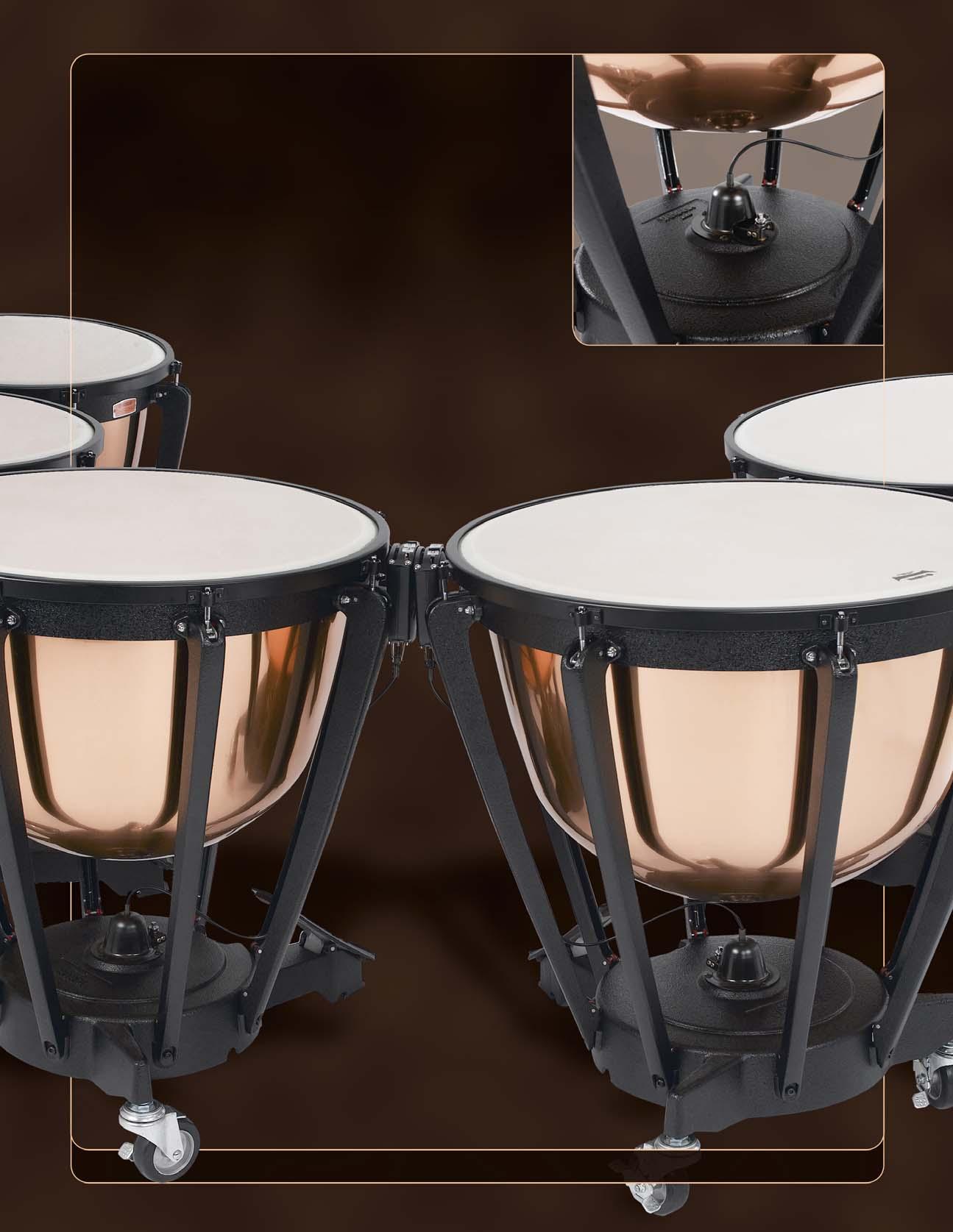 Adjustment Clutch
Adjustment Clutch


President Sara Womack Greystone Elementary School 300 Village Street Birmingham, AL 35242-6447 (205) 439-3200 sara@music.org
President, ABA John AustinCooper High School 1625 Danville Road SW Decatur, AL 35601 (256)john.cooper@dcs.edu 355-3829 School

Past PresidentSteve DothanMcLendon High School 1236 S. Oates St. Dothan, AL 36301 (334)dhstigerband@aol.com 794-0146 School

President, AOA Clay McKinney 1084 North and South Road Apartment 1F University City MO 63130 musicalistening@gmail.com
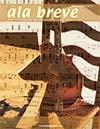

President-Elect Carl Hancock University of Alabama Box 870366 Tuscaloosa, AL 35487 (205) 348-6335 chancock@bama.ua.edu
Executive Director Editor, Ala Breve Garry Taylor 1600 Manor Dr. NE Cullman, AL 35055 (256) 636-2754 amea@bellsouth.net




Treasurer Chris Walker Clay-Chalkville Middle School 6700 Trussville Clay Road Trussville, AL 35173 (205) 379-3100 christopherwalker@jefcoed.com
Recording Secretary Carla Gallahan 212 Smith Hall, Troy University Troy, AL 36082 (334) 670-3502 School cgallahan@troy.edu






President, Collegiate AMEA Stephanie Pesto University of Alabama (256) 655-1432 sapesto@crimson.ua.edu
Collegiate AMEAAdvisor Moya SamfordNordlundUniversity School of the Arts/ Division of Music 800 Lakeshore Drive Birmingham, AL 35229 (205) 726-2651 minordlu@samford.edu













Unless otherwise indicated, permission is granted to NAfME members to reprint articles for educational purposes. Opinions expressed in this publication are not necessarily those of AMEA or the Editor. All announcements & submissions are subject to editorial judgement/revision.The Alabama Music Educators Association is a state unit of NAfME: The National Association for Music Education, a voluntary, nonprofit organization representing all phases of music education in schools, colleges, universities, and teacher-education institutions. Active NAfME/AMEA membership is open to all persons engaged in music teaching or other music education work.
the



















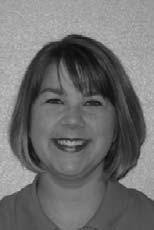
In the last issue, I quoted Oprah Winfrey as saying, “Nothing happens until you decide. Make a decision and watch your life move forward.” Almost 800 people made a decision to participate in this year’s conference to move their life forward and refocus their teaching with innovative, engaging, and relevant strategies to impact student learning. I appreciate everyone who attended and made the event possible. Executive Director Garry Taylor worked tirelessly to ensure the conference’s success. In addition, each Division President developed an amazing slate of clinicians and performing ensembles that offered refreshing and rejuvenating professional development. Visit page42 for a detailed overview of conference feedback from PresidentElect Dr. Carl Hancock.
Regrettably, the Governing Board, along with the majority of the AMEA membership, was disappointed with the performance of the Alabama Symphony Orchestra (ASO). We felt insulted and disheartened with the lack of enthusiasm displayed by the musicians and the apparent disconnect between Gabriel Kahane and our interests. It seemed that
the ASO was not concerned with our mission or purpose as music educators of Alabama.




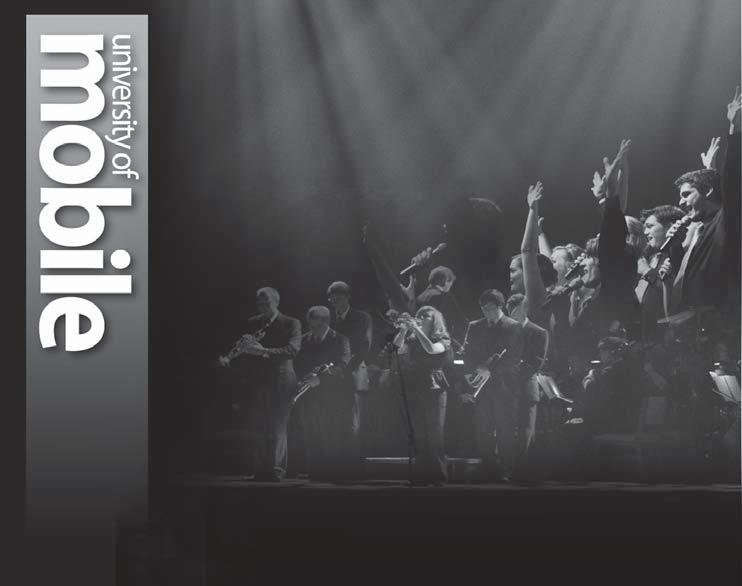
The AMEA leadership expressed our displeasure with the performance to the ASO administrators, who have written a letter of apology to our members (see page 9). They have assured us that the ASO shares our passion for music education and appreciates our impact on the students of Alabama. Therefore, they have offered to return to our conference next year at no cost to perform a more traditional program in collaboration with the members of AMEA. The conference schedule has been tweaked, so that the ASO performance will not decrease the number of school performances. The Governing Board is hopeful that this experience will build a stronger relationship with the professional musicians in the state and offer professional development and inspiration to Alabama’s music educators.



Previously, I outlined goalposts that would guide our organization over the course of my term and into the future. The AMEA Governing Board has made great progress towards the goalposts of increasing membership of underrepresentedpopulations, strengthening

relationships with current members, and intensifying advocacy efforts with a strategic design.



First, connections to younger members have been established through a new award for music educators that are just beginning their careers. The Outstanding Young Music Educator Award, which will be presented for the first time in January 2014, honors members that have shown a special dedication to and enthusiasm for music education in their third to fifth year of teaching. Download a form from our website to nominate an exceptional young music educator that has made an impact on music education in Alabama.
Another goalpost is building relationships with the music industry in Alabama through membership opportunities. A change in our bylaws, which was approved at the recent business meeting, created an industry membership category. This benefits AMEA by increasing our membership base and gaining more insight into how the music industry can assist our programs. Benefits to the industry members include a discount on advertising and exhibit prices, a representative on the Governing Board in an ex-officio capacity, as appointed by the President, an industry column in the Ala Breve, and a link to the industry members on the AMEA website. If you would like to nominate a member of the music industry to serve on the Governing Board, please send an email to sara@music.org.
Next, we are making connections to our more experienced and retired members by honoring our history. Dr. Frank Buck, who has been appointed as AMEA Historian, is working on a listing of previous winners of the Outstanding Music Educator Award, Outstanding Administrator Award, and the Barbara Odom Service Award. He is also compiling biographical sketches of AMEA Past Presidents for publication in our magazine and on our website. Dr. Buck’s work, found on page 39, is reflective and motivating!
University of Montevallo is an all-Steinway School featuring small class size and personal attention, offering the Bachelor of Music Degree in:

• Music Education
• Performance and the Bachelor of Arts degree in general music.
Competitive scholarships available!
2012-2013 AUDitionS:
Feb. 2 (scholarship auditions)
Feb. 23 (scholarship auditions)
March 9 (scholarship auditions)
April 6 (music auditions)
Join us for spring and summer events for high school students:
Middle & High School Honor Bands – March 1-3
Young Musicians’ Camp – June 16-21
www.montevallo.edu/music
In addition, a Past Presidents Committee has been established to utilize the expertise found within those who have served at the helm of AMEA. At the conference, a group of eight Past Presidents assembled for the first time to establish committee procedures and responsibilities. Immediate Past President Steve McLendon will act as chair and the committee responsibilities include serving as a resource for the Governing Board and recommending inductees into the AMEA Hall of Fame.
To strengthen relationships with current members, President-Elect Dr. Carl Hancock has piloted a survey to be distributed across the state. The data obtained from this survey will detail the needs and wants of the membership and assist in the formulation of the AMEA strategic plan, as well as the strategic advocacy plan. The survey will be distributed to the membership via email within the next few months.
Another goalpost to strengthen the relationship with current members is to offer innovative, engaging, and relevant professional development. The 2013 InService Conference was successful, but
improvements can always be made. On page 42, President-Elect Dr. Carl Hancock gives a detailed overview of the conference feedback, which was received through the Guidebook app and traditional conference evaluations. We appreciate everyone who shared their thoughts regarding the sessions and the overall conference.
Additionally, updating our procedures and planning for the future will strengthen the relationship to current members. Recent bylaw changes aligned our practices with our guiding documents and plans for updating the strategic plan are underway. The outdated officer and committee chair handbook will also be revised in the near future.
To intensify our advocacy efforts, the AMEA leadership has participated in two meetings of the Alabama Arts Advocacy Coalition (AAAC), which includes delegates from each of the arts education organizations in the state. Two areas of focus are the change in the graduation requirement for fine arts and the upcoming revision for the music course of study. At the upcoming AAAC meeting in late February, Superintendent of Education Dr.
Tommy Bice will discuss these two issues, as well as his vision for arts education in Alabama. In previous discussions, he has expressed his support of the arts and has assured the AAAC that these changes are not intended to negatively effect arts education. We are poised to act if negative consequences result from these modifications.
The AMEA Governing Board will continue to work toward the established goalposts. Please contact me at sara@music.org if you have any ideas or concerns regarding AMEA’s advancement.
Despite many shortcomings, the Alabama Symphony Orchestra was honored to be invited to perform in Montgomery for the 2013 AMEA conference, and we were especially pleased to be able to bring one of our nationally recognized “Classical Edge” performances to musicians, teachers and students who share a passion for the art form and its growth. As invited by AMEA organizers, the concert’s guest artist – and the conference’s keynote speaker – was acclaimed New York composer and singer-songwriter Gabriel Kahane, who’s in the forefront of connecting the grand traditions of the concert hall with the sounds of today’s generation. The ASO prides itself on this sort of creative programming, and feels that it is our responsibility to be leaders in education by paying equal attention to artistic excellence and innovation.
While we were pleased with the artistry and performance of Mr. Kahane and the orchestra, between the illness of a musician who had a key solo part in one of the planned pieces, and Mr. Kahane’s last-minute decision to modify his play list, the program was changed which resulted in an experience that was below expectations for a professional orchestra. We suffered a communication lapse among our staff and to our musicians, and unfortunately neglected to ensure that essential logistical information was shared. I deeply regret these errors and the negative impression they created.
In addition, some members of the audience have expressed disappointment that we did not present a more traditional symphonic program in both repertoire and presentation. I appreciate this feedback.
The Alabama Symphony Orchestra is thrilled to be invited back to the 2014 AMEA conference, and I would welcome your input as we plan our return performance for next January. Please feel free to email me at clong@alabama symphony.com with your suggestions on both what we should play in concert and any ideas you might have about how we could most effectively participate in your conference.
Thanks for all you do to further the cause of music education in Alabama!
 Curt Long Executive Director Alabama Symphony Orchestra
Curt Long Executive Director Alabama Symphony Orchestra
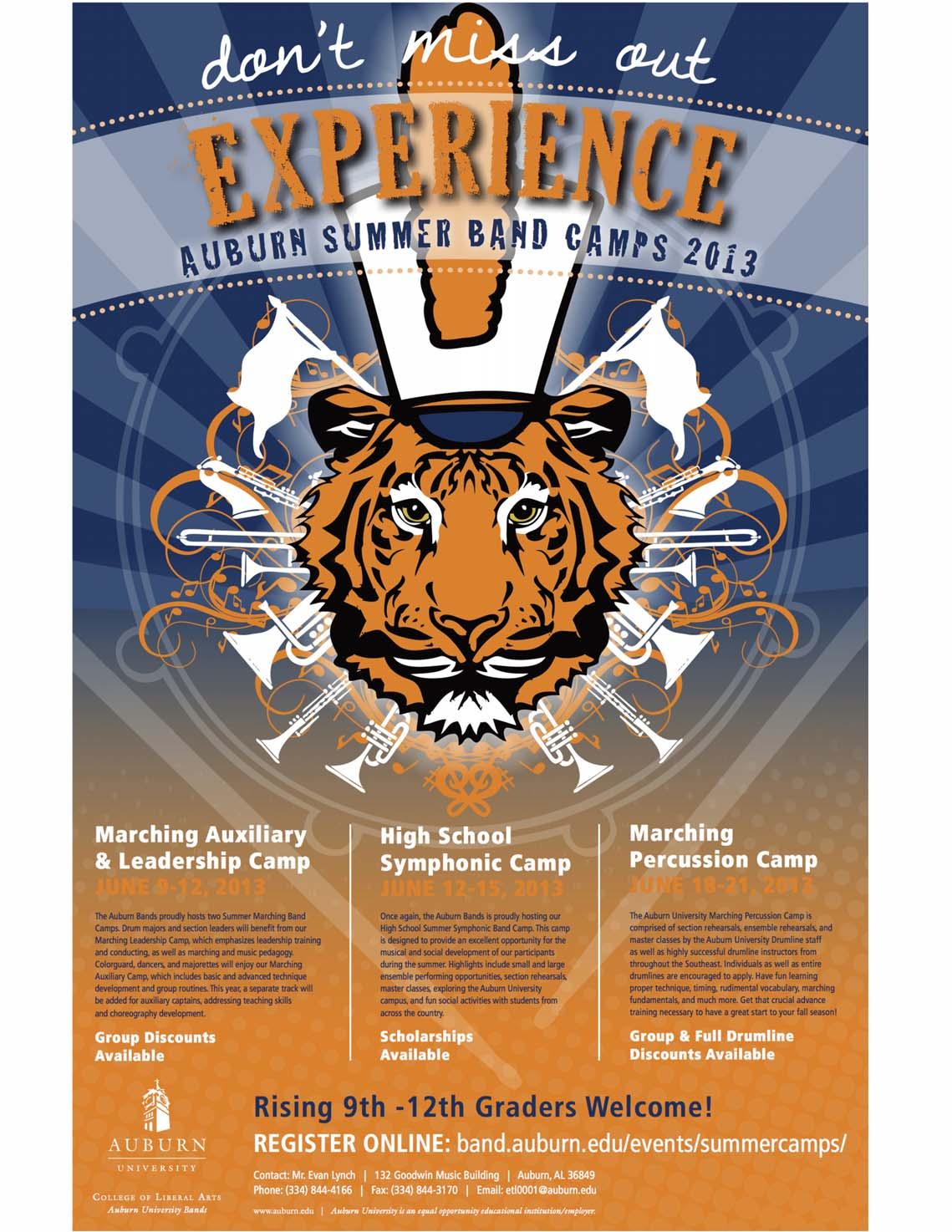
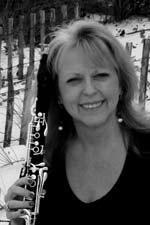


What an incredible conference! Kudosto all of the clinicians, conductors, and performing groups. A very special thanks to Garry Taylor, Executive Director for his outstanding organizational skills and unsurpassed wisdom and to Sara Womack, AMEA President, for her leadership and perseverance. We are fortunate to have such adept leaders in our midst. The Higher Education Division sponsored three clinicians, Dr. Jim Zingara, University of Alabama at Birmingham, who presented an instructive session titled, “Trumpet Chops 101”. Dr. Zingara demonstrated how to recognize poorly formed embouchures and provided some simple and effective ways in which to solve these problems without the invasive “start from the beginning while looking in the mirror” embouchure change process. Dr. William Powell, Auburn University led an engaging session on re-voicing This session focused on re-voicing choral music from mixed voices (SATB) to single-gender voices, primarily SSA(A) and TTBB. Dr. Yasmin Flores presented
“ Little Tweaks for your Budding Clarinetists: A Band Director's Guide to Teaching the Clarinet 5th - 12th Grade”. This session described the basics of clarinet playing with pictures and a trouble-shooting guide for squeaks and other odd problems one may encounter. Each of these clinicians presented material that was informative and practical for the music teacher of any teaching level.
The Poster Session represented three Universities, the University of Alabama, Auburn University and the University of Montevallo. Many thanks to Jane Kuehne, Auburn University for organizing this session. I encourage other universities professors to consider presenting for the next conference.
A wide variety of chamber music from the 19th to the 21st centuries was featured in the Higher Education Division Recital. Universities represented were the University of Alabama-Birmingham, University of Montevallo, Samford
University, Alabama State University, University of Alabama, Troy University, and Auburn University. The recital was well attended and well received.
Esteemed conductor Dr. Frank B. Wickes led the 2013 Alabama Intercollegiate Band. Many thanks to Sue Samuels for organizing this event. A fine program was presented, with a variety of impressive music, culminating with the arranged for band, Carl Orff’s Carmina Burana
As we have just brought this year’s conference to an end, it will be soon time to be thinking about applying for the 2014 AMEA Conference. I strongly encourage all higher education professors to consider applying to present a session. Everyone can benefit from your expertise and wisdom. I look forward to a great rest of the school year and to the 2014 AMEA Conference!

I would like to take this time to share my excitement about the collegiate division of AMEA! During this year, I have seen the entire state become closer and more involved at the collegiate level. It was readily apparent at January’s AMEA Conference that involvement in the program has increased greatly. Over ninety students attended, representing eight colleges and university. The conference was an educational and networking opportunity that I hope everyone will be able to attend next year, either as a student or a teacher.
During our time in Montgomery, the collegiate members attended sessions and concerts with all of the state’s music educators. On Thursday night a casual social event was held for all of the students to mingle and to get to know
their fellow colleagues from around the state. Times like those are invaluable to pre-service teachers. The colleagues and friends that we meet while in school often will become our lifelong colleagues and resources. At the business luncheon, which was held on Friday, the new Executive Board for Collegiate AMEA was elected. I am very excited to announce Ethan Lolley (University of North Alabama), Stacy Daniels (University of Montevallo), and Shuler Sitsch (The University of Alabama) as our new President, Vice President, and Secretary. Dr. Moya Nordlund will be serving her last year as Collegiate Advisor. We welcome Dr. Ted Hoffman onto the Executive Board as CoCollegiate Advisor to insure a smooth transition in the coming year. No doubt, this will be a successful year with this
team of leaders. I wish them all the best of luck.
At this time I would like to express my sincere gratitude to the entire Alabama Music Educators Association for allowing me to serve you as the collegiate president. It has been an honor and a pleasure to have the opportunity to work with my fellow board members Julia Baxter and Vincent Schneider this year. I am so proud of our collegiate division, and I see growth in numbers, service and camaraderie in the coming year. Congratulations to the new Executive Board, and thank you again for allowing me to serve as this year’s president.
Stephanie Pesto - President, Collegiate AMEA
“A teacher can either cement mediocrity or inspire excellence in a student, regardless of what subject is being taught.”
The faculty of which I am a part is participating in a book study. I read the previous quote in the first chapter of the book and was inspired. Teachers have the opportunity and responsibility to expect and inspire excellence in our students; however, we as music teachers are so blessed to fulfill that responsibility through teaching such a joyous subject to children. The question is how do we accomplish such a task?
Senator Lamar Alexander in his remarks at the recent presidential inauguration referred to a quote from Alex Haley’s book Roots. “Look for the good and praise it.” What a promising strategy for inspiring excellence in our students. Human beings thrive on support and encouragement. We, as music teachers, have many opportunities to enact this strategy. Our encouraging words may be the only ones these children hear that day. Our classes are designed to allow optimal participation and engagement while also allowing for creativity. Students may be successful and engaged in our class despite the fact they may struggle in other classes.
1946Yale H. Ellis
1948Walter A. Mason
1950Vernon Skoog
1952John J. Hoover
1954Lamar Triplett
1956Carleton K. Butler
1958Mort Glosser
1960Wilbur Hinton
1962Lacey Powell, Jr.
1964G. Truman Welch
1966Jerry Countryman
1968Floyd C. McClure
1970Jerry Bobo
1972Frances P. Moss
1974George Hammett
1975Frances P. Moss
1976S. J. Allen
These students will strive to meet our expectations when they are consistent and their efforts are encouraged.
Our classrooms are also the places in our schools where creativity is expected and encouraged. People of the world today must have creativity and problem solving skills to be successful and contributing citizens. In the current state of high stakes testing pressure, teachers often relinquish what they know as best practice to test preparation. In our music classes, we have more freedom to design lessons that encourage problem solving and creativity. As we work with children in large and small groups to create and perform music, we are also teaching the critical skills of working with others for a common goal. Children often learn to respect and value people, cultures, and music different than their own through our classes. We have the opportunity to expose children to music from all historical periods as well as music from across the globe. Not only can we teach objectives from our state course of study and the national standards for music, we also can teach history, geography, culture, as well as respect for others.
How many times do your lessons include math, language arts, or science? How often is dance, drama, or visual arts a part of your activity for the week? Our
classrooms have the potential to accomplish a great deal for our students. We strive to teach our curriculum with depth and meaning, as we endeavor to integrate other subject matter and build character. You matter. You are important.
Bobby Horton, a musician from Birmingham, told a group of teachers in a workshop this week, that teachers are the ones who determine the future of our country and the world. I certainly believe we contribute in a powerful way. Thank you for the job you do everyday for the young people of our state. Keep up the good work. You make a difference in your school, your community, our state, our country, and even the world. Continue to be great and inspire excellence in your students.
Covey, S. R. (2008). The Leader in Me: How Schools and Parents Around the World Are Inspiring Greatness, One Child at a Time. New York, NY. : Simon & Schuster.
March 2, 2013 AOSA presents Roger Sams

Orff Level One Certification Training in June at Samford University
October 4,
October
1978W. Frank McArthur, Jr.
1980Paul Hall
1982Lacey Powell, Jr.
1984Johnny Jacobs
1986Merilyn Jones
1988Ronald D. Hooten
1990Ken Williams
1992Dianne Johnson
1994James K. Simpson
1996Johnnie Vinson
1998Michael Meeks
2000John McAphee, Jr.
2002Tony Pike
2004Becky Rodgers
2006John Baker
2008Pat Stegall
2010Steve McLendon
2012Sara Womack

Hi! I hope the year is going well and that your spring performance plans are coming along. As always, if I or anyone else in the AOA can help you in promoting or supporting your orchestra performance please don’t hesitate to ask. We want to continue to expand our programs and build on the things we have accomplished. We have many new orchestra opportunities in addition to the great ones that have been in place for some time in our state, I encourage you to seek them out for your students.
One opportunity for those students living in the Southeast District is coming up in April. The Southeast District will again be hosting an honors orchestra festival in Dothan Alabama. This is the 2nd year for the festival and Michael Gagliardo will be the guest conductor for the orchestra. For more information please contact the Southeast District chair, Eugene Conner through our website www.alabamaorchestraassociation.org

Eugene has done a fabulous job organizing this event so that the students will have a fun and wonderful learning experience.
All State was a great success this year again thanks to the many people who come together to make it so. It also goes without saying that the students did a terrific job. Every year the level of musicianship grows and the concerts continue to get better and better. Our newly
expanded Sinfonia Orchestra was a great success, and we plan to continue that next year. Thank you to all the band directors who encouraged your students to audition. We needed more auditions from winds, brass and percussion this year and we got them, so a very sincere thank you to everyone that helped spread the word. We need even more next year and I know we can work together to help bring this experience to more students. I also want to thank all of the parents and teachers who help with registration and other parts of the festival. This is an indispensible part of the festival and we greatly appreciate it. I also want to thank our board, most of whom have served for many years, Lisa Caravan, Vice-President/President Elect, Marcy Wilson, Past President, Daniel Jamieson, Treasuer, Felicia Sarubin, Secretary and Julie Hornstein, Executive Director. These are the best people to work with and help make this organization great, so when you have a chance thank them in abundance. I have also been blessed in my time as president to work with outstanding district chairs. In the Northern District, Daniel Jamieson, Jacob Frank and Daniel Hornstein. In the Central District, Sarah Nordlund, Zak Enikeev and Julia Sakharova. In the East Central District, Roland Lister. In the West Central District, Dr. Anne Witt. In the Central District, Sarah Schrader. In the Southwest District, Felicia Sarubin. In the Southeast District, Eugene Conner. They have been extremely generous with their time over the years in order to make the All State festival a success.
We are also fortunate in that we are able to collaborate with other orchestra organizations
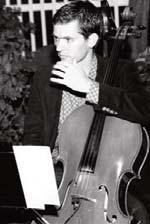
in the state as well as professional musicians to bring the best experience to our students. The AOA would like to thank the University of Alabama School of Music and it’s faculty, The Alabama Symphony, The Huntsville Youth Orchestras, Osiris Molina at the University of Alabama. Peter Povey of the Montgomery Music Project, Bryan Reeves at Alabama State University, and Michael Fernandez of the Alabama Symphony. While I am mentioning professionals, I want to again say thank you to our Vice-President and soon to be president Dr. Lisa Caravan. She is going to be a great leader for AOA and someone everyone is going to enjoy working with.
One of the things Lisa has already done to provide great leadership was at the annual AMEA conference. I would like to challenge the rest of our string teachers in the state to do the same in 2014. Submissions of proposals for the 2014 AMEA conference are now being accepted. We have many great string teachers in the state and I know we can learn from one another. If you have a topic you would like to present at the conference please go to the AMEA website at www.alabamamea.org and find the application forms. We want to hear from you and we definitely want to see you at the conference in 2014. This is a time to meet and collaborate and share ideas about our programs. It is within our reach to provide orchestra education to every student in the state of Alabama if we come together and work together. The AMEA conference is also a time to hear performances from our groups in the state. There is a performance opportunity on the main stage of the Montgomery Performing Arts Center and there are various performing opportunities in the lobby and common areas of the conference center. Two notable performances this year came from the Carver Elementary Orchestra under the direction of Dr. Tom Boyd and from the Montgomery Music Project under the direction of Laura Usiskin. Thank you to these teachers for bringing your groups and being a part of performing for the conference. The importance of this aspect of the conference cannot be over stated and so I hope others will come and perform next year.
As always, it is my great fortune to serve in this capacity and if I can ever be of assistance do not hesitate to ask.

“I can’t tell you how much we love it! The kids are so excited about it. I’ve been teaching for 29 years and can’t wait to get to school each day to do Quaver. Thanks so much for this most excellent program!”

Sherri Stoddard Thompson Jefferson Elementary, Shawnee, OK








“My students talk about Quaver all the Now I have kids quoting music history facts to me – with genuine enthusiasm! They are learning so much faster and retaining concepts longer because of Quaver.”

















TX






































“I love the Quaver Quizzes that can be used after each episode. They are great to use as a formative or summative assessment. It has been such a refreshing way to introduce, enhance, and assess core content! My students love Quaver’s Marvelous World of Music!”










Lisa Hussung – Rich Pond Elementary Bowling Green, KY

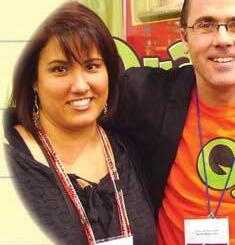





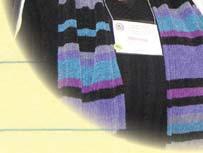







“I am so excited to use Quaver’s lessons as the centerpiece of my curriculum next year.”
Donna Berg – Darien Elementary, Delavan, WI
“Quaver Music has made a huge impact on my music classes.”
Penelope Campbell Willbern Elementary Houston,


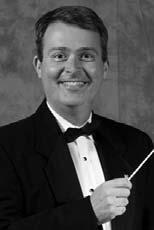

It was a pleasure to see and speak to so many during the Alabama Music Educators Association Conference. I want to express my thanks to each for your participation in our concerts, clinics and meetings. The AMEA Board of Directors values your input and suggestions. All the comments you make concerning our conference are read carefully.

This year, an unusually high number of bands applied to perform. If your band was not selected, please apply again. It does not mean that you were not good enough! An effort is made to try to include bands of different levels, from different areas of the state, and from different school sizes and situations. This year that was made more difficult because of the addition of the Intercollegiate Band and the Alabama Symphony to the schedule. Apply again! One of the suggestions was to not schedule events the ABA members would enjoy at the same time. Actually, at any point in the schedule, there is only one ABA event. However, many times a division will schedule a clinic that would be beneficial and would be enjoyed by more than one division. This is a wonderful problem!


Hopefully we can schedule those clinics again in the near future.










Clinics are selected based upon clinic proposals that are sent to the AMEA Executive Secretary. Sometimes comments indicate that there were too few woodwind clinics, and too many brass clinics. Again, an effort is made to balance and include many different areas, but a clinic cannot be scheduled if there is no proposal. I thought the clinics this year were especially good. They were full of practical information and I heard so many good comments from clinics that I was unable to attend.
I would also like to thank all the exhibitors. Without a doubt, even with the outstanding clinics and concerts, strolling through the exhibits, visiting with friends, and doing a little shopping is one of the best parts of the conference. Is there an exhibitor you especially enjoy? Thank them for being there! Is there one you miss? Tell them! This year’s conference posed a conflict with the Florida conference, but that should not be a problem in the coming years.
Finally, thanks to all the ensembles that performed – the Shades Valley HS Percussion Ensemble (Greg Gumina), the Pelham HS Wind Ensemble (Jeff Burnside), the Auburn HS Honors Band (Rusty Logan), the Homewood City Schools Percussion Ensembles (Chris Cooper), the Jacksonville State University Winds (Kenneth Bodiford), and the Alabama Symphonic Band (Randall Coleman). Those ensembles and their directors are the ones who really had to work to get ready for the conference. This year, maybe more than most, they all did a great job.
All-State Band Festival will be moving to Huntsville this year. We want to thank the University of Alabama in Huntsville for hosting our State Solo Festival and First Baptist Huntsville for hosting our chair tryouts. If you have not made your room reservations yet, please make sure you do so by using the ABA Housing Form on the website. I hope to see everyone at AllState!
Wednesday, April 17, 2013



All-State Solo Festival

Thursday, April 18, 2013
David Gregory, Director of Bands at Reinhardt University and Director Emeritus of Tara Winds, has conducted elementary, junior high, high school, community college, university, and professional bands.

A former director of bands at Hardaway High School in Columbus (GA), Forest Park High School in Forest Park (GA), and the University of Florida in Gainesville, (FL), and former Clayton County (GA) Coordinator of Instrumental Music, Dr. Gregory served as Assistant to the Superintendent in that school system for twelve years until his retirement from public school work in January 2003. Dr. Gregory is a Past President of the National Band Association and currently serves as Advisor to the Executive Committee of that organization.
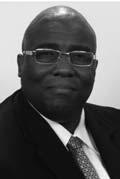
gamut from professional chamber players to 450 piece string orchestra, symphony orchestras and wind ensembles to mass bands of over 1500 musicians. He is bestknown as a major authority on music for wind groups and in this capacity he has appeared as featured conductor for many professional organizations. These include the World Association for Symphonic Bands and Ensembles (WASBE), the College Band Directors National Association (CBDNA), the American Bandmasters Association (ABA), the MidWest Clinic, the Music Educators National Conference (MENC), the Encontro Latino Americano (Brazil), the Shizuoka Festival (Japan), the British Association for Symphonic Bands and Wind Ensembles (BASBWE) and others.
William Owens (b. 1963) is a native of Gary, Indiana. He is a seasoned music educator and very active as a composer, clinician and conductor throughout the United States and Canada. His compositions for young ensembles display a practical, erudite approach which has firmly established him as a leader in the field.
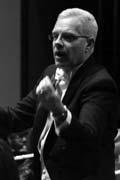
Dr. Glenn D. Price recognized as one of the leading international conductors of today. He has conducted in over 20 countries on five continents, covering the

David Starnes joined the School of Music at Western Carolina University in the summer of 2011 as Assistant Professor/Director of Athletic Bands. He directs the Pride of the Mountains Marching Band and the Symphonic Band. A native of Chattanooga, Tennessee, Mr. Starnes graduated magna cum laude from the University of Tennessee, Knoxville in 1988, where he earned a Bachelor of Science degree in Music Education. Prior to coming to Western Carolina, Mr. Starnes was the founding Director of Bands at Kennesaw Mountain High School in Kennesaw, Georgia, where he served for eleven years.
Since 1993, Mr. Owens has writtren over 150 commissioned and published works for concert band, string orchestra and small ensemble. His music is programmed at prestigious venues such as the Midwest Clinic, and appears on music lists both nationally and abroad. Principal commissions include those from the the California Band Directors Association, the Florida Bandmasters Association, the Iowa Bandmasters Association, the South Plains College (TX) Department of Fine Arts and the Texas University Interscholastic League. His compositions "Courtlandt County Festival" and "Maesong" have been recorded and analyzed in educational text by the GIA series Teaching Music Through Performance In Band. Mr. Owens teaches instrumental music in the Everman (TX) Independent School District and is the Instrumental Editorial Assistant for the FJH Music Company.






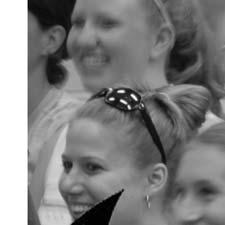


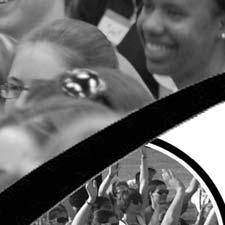






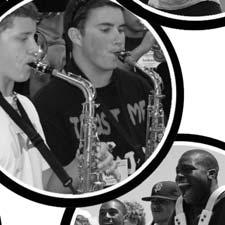







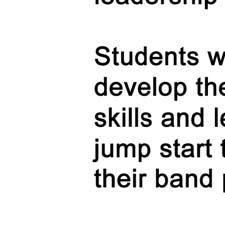
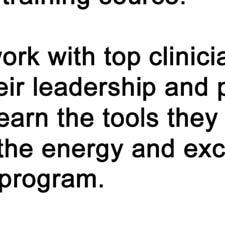


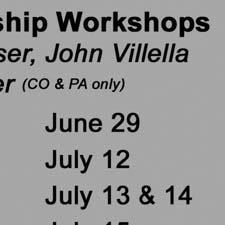

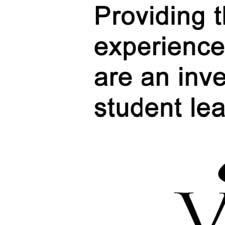
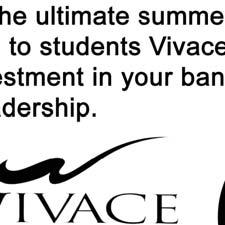
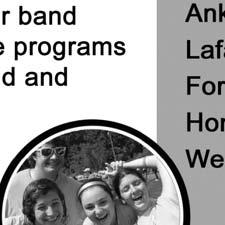

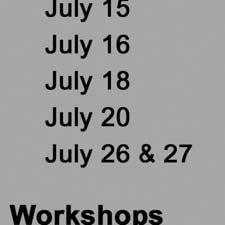







This month, Tips That Click will review several DVDs that should be of special interest to directors of middle school and high school bands. These discs should prove useful for both classroom instruction and professional development and are easily available and reasonably inexpensive. I have been able to obtain these recordings from Gadsden Music Company(http://www. gadsdenmusic.com/) and Art’s Music Shop (http://artsmusicshop.wordpress.com/).
The first recommendation is a DVD from Bravo Music (http://cart.bravo musicinc.com/), which is the American branch of the Hiroshima-based BRAIN Co. music publishing company. This company specializes in importing the top Japanese wind literature, but also produces and sells an amazing array of videos. One of these that I can highly recommend is: Frederick Fennell Remembered. This video showcases the late Maestro with the Kosei Wind Ensemble in a varied program of original wind literature and transcriptions. I am constantly awed by the conducting ability of Dr. Fennell, even though this was recorded in his last years. My middle school students have enjoyed watching portions as there are many soloists featured throughout the compositions. I always try to highlight a portion with an outstanding player, even though I might not have them watch the entire piece. I just embed a small section of


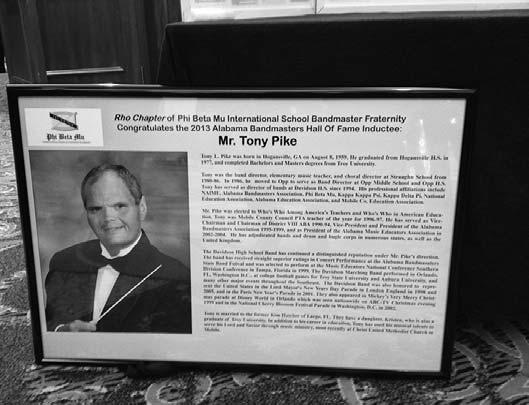
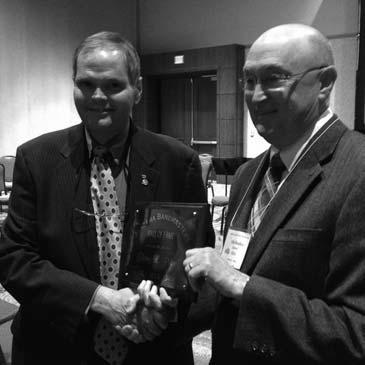
video into our lesson to give them a vivid demonstration of characteristic sound and correct posture.
The second DVD of note is the 2009 Japan Wind Orchestra and Ensemble Competition-Elementary Division. This product is distributed by Bravo Music and available from our Alabama music stores. There are other discs with the Jr. High and High School performances on them, but I have found that the elementary performances seem to have the most impact on students and directors. To hear and see such immaculate performances coming from young children is amazing! As a university student in the 70’s, I can remember my mentor, Dr. A.R. Casavant, playing me LP records of some of the Japanese elementary bands, but it never struck me how young these children really were, and the depth of their musical maturity until I saw video. I obtained a VHS video in the late 90’s, and I remember going to the Texas Bandmaster’s Association convention and spotting a representative from Bravo Music at one of the booths. I loved the performances, but I was assuming that they were put together by an “all-star” group. When I asked this older Japanese gentleman about the elementary school band on the video he bowed, shuffled, looked down, and acted rather embarrassed. He then looked at me and responded: “Well….not exactly like elementary school here”. He then continued: “Elementary school band in Japan have 4th, 5th AND 6th grade”. I almost burst out laughing at the thought that he was apologizing for thinking having the 6th grade gave them an unfair advantage. We watch portions of these as “bell ringers” at times, and I also play them without sound so that students will look at
the posture and decorum of these groups. My colleague, Scott Thompson, used to get students thinking with: “How much talking do you think goes on in that group?” or; “How much excess finger motion do you see?” I have several years of these contests- any of them are great watching and listening!
I realize that some of these groups have videos on YouTube, but I promise it is worth the small investment (less than 35.00) to purchase some or all of these for you and your students. It is not the type of thing you want to leave for a sick or convention day, but judicious use of these resources with students can pay great dividends!
Part II will cover some DVDs that will help directors in directly planning their instruction. Rho Chapter of Phi Beta MuInternational Bandmaster Fraternity is committed to improving quality instruction and advancement of bands in this state. Please email pemin@mac.com with any comments on this column or suggestions for future columns.

Rho Chapter of Phi Beta Mu International Bandmaster Fraternity is committed to improving quality instruction and advancement of bands in this state. Please email pemin@mac.com with any comments on this column or suggestions for future columns.







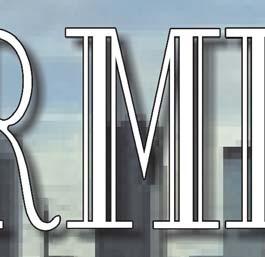


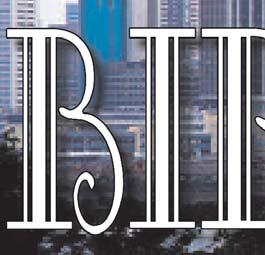







Like many states, Alabama is experiencing various budget reductions. These funding cuts have the potential to be devastating for arts programming at local and state levels. Now more than ever, supporters of the arts must be informed, and actively engaged. However, while many Alabamians ardently support the arts, an established advocacy outlet does not exist. Supporters of the arts need an outlet that will give them information, support, and connect them to a larger arts advocacy movement. Without a strategic approach, a unified voice, and a mechanism for mobilization, the arts advocacy efforts in Alabama will remain fragmented.
The Alabama Alliance for Arts Education is uniquely positioned to offer a solution to meet the need for an arts advocacy outlet. Donna Russell, the AAAE Executive Director, serves as the official Arts Advocacy Captain for Alabama on behalf of Americans for the Arts. The combined strengths of the AAAE board members and associates provide direct
access to tested advocacy strategies and techniques. Most importantly, to advocate on behalf of the arts is crucial to the mission of AAAE. In fact, arts advocacy is a cornerstone of our organization.
In order to meet this challenge, AAAE has formed an Advocacy Committee, tasked with the development of the AAAE Advocacy Coalition. The AAAE Advocacy Coalition will respond to the need for a state-wide arts advocacy effort.
The mission of the Alabama Arts Advocacy Coalition is to unite Alabamians in support of the arts, raising awareness of the role of the arts in our schools, communities, and individual lives, mobilizing support for the preservation of the arts for generations to come.
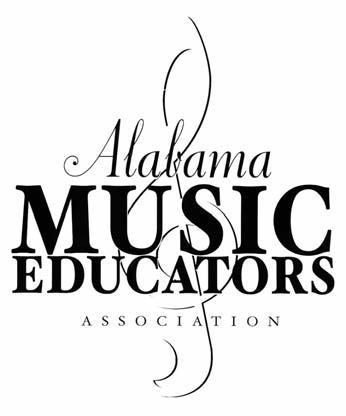
The purpose of the Advocacy Coalition is to serve as a coordinator of arts advocacy efforts in Alabama. The Advocacy Coalition shall develop an operating strategy for arts advocacy. This strategy
will identify points of entry for individuals, organizations, and other representatives throughout the state so that they may join the advocacy efforts.
The goal of the Arts Advocacy Coalition is to Inform, Inspire, and Organize arts advocacy efforts in Alabama.
Inform: The Arts Advocacy Coalition will provide resources, information, and guidance to arts advocates, serving as an access point to arts advocacy in Alabama.
Inspire: The Arts Advocacy Coalition will initiate Calls to Action, inspiring arts advocates to get involved, and raise their voices in support of the arts in Alabama.
Organize: The Arts Advocacy Coalition will organize arts advocacy events and campaigns, mobilizing our network of arts advocates in support of the arts in Alabama.
Alabama Arts Advocacy Coalition: L to R: Garry Taylor, Rosemary Johnson, Sara Womack, Tracey Chaplin, Al Head, Donna Russell, Michelle Eller, Diana Green, Sara Wright, and Larry Gibson.

As I sit and pen this article, I am amazed at the superb caliber of the choral programs across the fine state of Alabama. It was so nice to see and network with so many of our outstanding directors at the AMEA Inservice Conference. It truly makes me realize, with great humility, the privilege to lead such a wonderful organization. The AMEA conference was well attended by our fellow AVA colleagues. Thank you all for attending and supporting our sessions. Many of these sessions had more participants than I have ever seen attending.
Thank you so much to our presenters who inspired and encouraged us to take their ideas and gifts back to our classrooms. Thank you especially to Richard Bell with his “Advocacy from the School House to the State House”, John Flanery with “10 Ways to Energize Your Choral Rehearsal Everyday”, Patricia Corbin with “Oldies but Goodies”, Ian Loeppky with “Using Your Computer Tablet as a Music Folder”, and Deborah Baker with “Incorporating Commissions, Guest Conductors, and Artists to Your Music Program”.
Thank you also to our wonderful performing groups. My hat is off to you all who brought such well prepared and enlightening groups to share with us. Greg Fuller and the USM Chorale, Patricia Corbin and the JSU A Cappella Choir, Allen Gillespie and the HewittTrussville High School Chamber Choir, Damion Womack and the Montgomery Academy Upper School Chorus, and Ian Loeppky with the UNA Collegiate Singers, Chamber Choir, and Vocal Jazz Ensemble. All of you truly out-did yourselves.
The All-State Show Choir had an incredible experience and performance under the musical direction of our good friend Paul Gulsvig and choreographer extraordinaire Jarad Voss. It is overwhelming that these gentlemen can put together and perform such a wonderful program in just two days. Great Job! Thank you so much Jane Powell for coordinating this entire effort. Thank you also to our volunteer band, too.
You guys are awesome! Our accompanists should also be commended for their hard work during the conference. Thank you so much to Terry Moore for accompanying the AllState Show Choir. And a huge thanks to Cathy Shelton for accompanying the “Oldies but Goodies” Session with Patricia Corbin.

I am truly honored to be surrounded by people who are willing to go above and beyond to provide greatness for the conference. Jerry and Jordan Cunningham, who took care of the ASSC risers and platforms and were the liaison to the MPAC crew, Liz Donaldson and her booster parents who provided food during the conference, the AVA Executive Board and AVA Board for making sure everything was done and taken care of… You guys are seriously true servants. Thank you so much to Pat Blackwell, our Executive Secretary, for doing it all…all of the time!
It is now time to look ahead to the All-State Choral Festival. We are indebted to Samford University, Dr. Joe Hopkins, Dr. Phillip Copeland, Dr. Moya Nordlund and the staff for handling the logistics of a huge festival and allowing it to run smoothly. We look forward to working with outstanding clinicians. The SATB Choir with Dr. Eric Nelson from Emory University, the SSA choir with Dr. Janet Galvan from Ithaca College, the TTBB choir with Dr. John Flanery from USM, the Middle School Mixed Choir with Dr. Elizabeth Parker from the Schwob School of Music at Columbus College, and the Middle School Treble choir with Dr. Judy Bowers from Florida State University.
It is also time to think about our State Choral Performance Assessments and our State Solo and Ensemble Assessments. Many of you have spent countless hours working with your students across the state to prepare them for this endeavor. I would also like to thank again Dr.
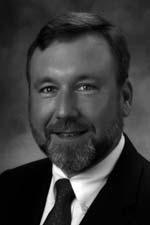
Carl Davis and Ginny White for their dedication to the continuing evolution of our adjudication forms. I hope you all “break-a-leg” with each and every performance you create.
Thank you to each and every one of you who tirelessly work to promote the choral art with your students in the classroom every day. Sometimes it seems like a thankless task, but know this… It is you and your tutelage that really makes the difference in thosestudents lives. Keep up the good work!
See you all in March at All-State.

Wednesday–March 6, 2013
11:00 a.m.AVA Board Meeting
Wright Basement
2:30 p.m.OA Competitions/Picture
3:00 p.m.Female OCS Competition
Brock Recital Hall
4:45 p.m.OCS – Picture
Brock Recital Hall
5:00 p.m.Male OCS Competition
Brock Recital Hall
7:00 p.m.ASSC Band Rehearsal
Wright Performance Center
Thursday–March 7, 2013
8:00 – 11:30 a.m.All-State Show Choir Rehearsal
Wright Performance Center
Friday–March 8, 2013
8:30-11:30All-State Rehearsals
HS SATBReid Chapel
HS SSABrock Recital Hall
HS TTBBBolding Studio
MS MixedWright Performance Center Stage
MS TrebleCassesse Band Hall
Stage
10:00 a.m.–1:00 p.m.Registration
Wright Basement
11:00 a.m.Luncheon Meeting
Wright Mezzanine
(President, President-Elect, Clinicians, Accompanists, Coordinators)
12:00-12:30 p.m.ASSC Dress Rehearsal
Wright Performance Center
Stage
1:00-1:45 p.m.General Assembly
Wright Performance Center Directors & Students
Samford A Cappella Choir
ASSC Performance
2:00 – 5:30 p.m.All-State Rehearsals
HS SATBWright Concert Hall
HS SSABrock Recital Hall
HS TTBBBolding Studio
MS MixedReid Chapel
MS TrebleCassesse Band Hall
5:30-7:30Dinner Break
7:30-9:30 p.m.All-State Rehearsals
Same sites as first rehearsal
11:00 p.m. Curfew
Wright Mezzanine
(AVA Board, Clinicians, Accompanists) 1:30-4:30
HS SATBReid Chapel
HS SSABrock Recital Hall
HS TTBBBolding Studio
MS MixedCassesse Band Hall
MS TrebleWright Performance
Saturday-March 9, 2013
(Performers Seated)
OCS/OA/ME District Winners
(Assigned seats in front of auditorium) OCS/OA/ME State
chapter of the American Choral Directors Association, and is the recipient of a “Crystal Apple” award for excellence in teaching at Emory University and the “American Prize” in Choral Conducting. He holds degrees in voice and conducting from Houghton College, Westminster Choir College, and Indiana University.
Aquinas Catholic Church in Hattiesburg.
Eric Nelson is Director of Choral Studies at Emory University, where he conducts the Concert Choir and the University Chorus. He also teaches graduate Choral Conducting, Methods and Literature. In addition, Dr. Nelson is the Artistic Director of the Atlanta Sacred Chorale, a professional chamber choir specializing in sacred a cappella repertoire, and the Minister of Music at the historic 2nd-Ponce de Leon Baptist Church in Atlanta.
He has conducted choirs throughout North America and Europe, including performances in London, Rome, Krakow, Berlin, Leipzig, Prague, Moscow, Washington, D.C., Carnegie Hall, Lincoln Center, and the Sydney Opera House. His choirs have appeared at six American Choral Directors Association conventions, including the Concert Choir’s performance at Chicago’s Orchestra Hall for the National Convention in 2011 and the Atlanta Sacred Chorale’s performance in Winston-Salem for the Southern Regional Convention in 2012. His ensembles have been praised for their ability to combine a high level of technical precision with warmth of musical expression.
Dr. Nelson’s compositions have been sung by choirs throughout the United States, including performances for the American Choral Director’s Association, the Music Educators National Conference, the Association of Lutheran Church Musicians, the Presbyterian Association of Musicians, the American Guild of Organists, and for numerous churches, colleges and universities.




Dr. Nelson is past President of the Georgia
John Flanery is Assistant Choral Director and Associate Professor at the University of Southern Mississippi. His Doctor of Musical Arts and Master’s degrees are both in Choral Conducting from the University

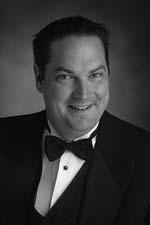
As a high school music educator in the state of Iowa for nine years, John conducted concert choirs, madrigal dinners, show choirs, jazz choirs, and many other ensembles. John is a regular clinician and judge throughout the Midwest and Southeastern United States. He and his wife, Juliane, have four children, Elias, Cecelia, and Josephine, and Lucinda.
Dr. Janet Galván, Professor of Music at Ithaca College, conducts the Ithaca College Women's Chorale, the Ithaca College Chorus, and is Artistic Director for the Ithaca Children's Choir. Her New York colleagues recognized Dr. Galván’s contribution to choral music in 1995 when she received the American Choral Directors Association (ACDA) New York Outstanding Choral Director Award. In 2010, she founded the chorus UNYC that has performed with the Cayuga Chamber Orchestra (Lanfranco Marcelleti, conductor).
of Kentucky. He holds a Bachelor’s of Music Education degree from Briar Cliff University in Sioux City, Iowa.
At Southern Miss, John teaches choral conducting, choral procedures, and choral literature, directs the Concert Choir, Spirit of Southern, Men’s Chorus, and the Southern Miss Gulf Coast Civic Chorale. His ensembles have been selected to perform at various state and regional conferences and concert series.
He founded the Festival of Choirs on the Mississippi Gulf Coast, which comprises the Civic Chorale and area high schools in a non-competitive concert. The Southern Experience Show Choir and Choral Camp was founded under Flanery’s guidance with over 500 junior high and high school students and teachers attending in its first four years.
John has served ACDA in various positions, currently serving as the Mississippi Chapter President. He has a new choral series with Colla Voce publishing company. He is also the church choir director at St. Thomas
In demand as a guest conductor, Galván has conducted national, regional, and all-state choruses throughout the United States in venues such as Carnegie Hall, Washington’s Constitution Hall, Minneapolis’ Symphony Hall, Pittsburgh’s Heinz Hall, and Nashville’s Schermerhorn Symphony Center. She has conducted her own choral ensembles in Carnegie Hall, Lincoln Center’s Alice Tully Hall, and Avery Fisher Hall as well as in concert halls in Ireland, Italy, the Czech Republic, Austria, Canada, and Spain. Her choral ensembles have also appeared at national, regional, and state music conferences. She has conducted the chamber orchestra, Virtuosi Pragneses, the
State Philharmonic of Bialystok, Poland, the Cayuga Chamber Orchestra, the Madrid Chamber Orchestra, and the New England Symphonic Ensemble in choral/orchestral performances. Galván was the sixth national honor choir conductor for ACDA, and was the conductor of the North American Children’s Choir which performed annually in Carnegie Hall from 1995-2007. She was also a guest conductor for the Mormon Tabernacle Choir in 2002. Galván has also been a guest conductor and clinician in the United Kingdom, Canada, Belgium, Austria, the Czech Republic, Greece, and Brazil as well as national and regional choral and music education conferences and the World Symposium on Choral Music. She was on the conducting faculty for the Carnegie Hall Choral Institute, the Transient Glory Symposium in February of 2012.
Galván has two choral music series with the Roger Dean Publishing Company and is the author of chapters in two books, Teaching Music through Performance in Choir, Volume 2 and The School Choral Program: Philosophy, Planning, Organizing and Teaching. She is also the series advisor to Latin Accents, a series with Boosey & Hawkes. Her article on the changing voice was published in the International Federation of Choral Music Journal in August of 2007 and was reprinted in La Circulare del Secretariat de Corals Infantils de Catalunga.
Galván has been recognized as one of the country’s leading conducting teachers, and her students have received first place awards and have been finalists in both the graduate and undergraduate divisions of the American Choral Directors biennial National Choral Conducting Competition. Dr. Galván was a member of the Grammy Award-winning Robert Shaw Festival Singers (Telarc Recordings).
Galván is the founder and faculty advisor of the Ithaca College ACDA Student Chapter. This chapter has won Outstanding Student Chapter at the last three national conventions of ACDA. She is past president of NYACDA.
Dr. Elizabeth Cassidy Parker is the Assistant Professor of Vocal Music Education at the Schwob School of Music at Columbus State University as well as the Artistic Director of the Voices of the Valley Youth Choir. She holds the Doctor of
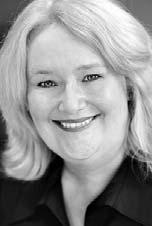
Philosophy degree from the University of Nebraska-Lincoln, as well as bachelors and masters degrees from Oberlin Conservatory of Music. Dr. Parker held the position of Director of Music of a large New York City non-profit where she conducted a children’s choir program of more than 250 voices. She also taught general and choral music at two independent schools in Brooklyn, New York. Dr. Parker’s choirs have commissioned works by Daniel Brewbaker, Robert Convery, Malcolm Dalglish and Peter Eldridge, as well as toured Puerto Rico, Spain, and Canada. As a choral singer, Dr. Parker sang with Robert Shaw and
Mixed Chorus
Distinguished Service Award from Florida ACDA Chapter. Bowers frequently presents
Treble Chorus
workshops and clinics for teachers, and her research interests include developmental choral groups, the adolescent voice change, and learning partnerships.

James Conlon at Carnegie Hall. She has presented her research at the American Educational Research Association, NAfME’s National Society for Research in Music Education, the National American Choral Directors Association, the Mayday Colloquium XXII, the Desert Skies Research Symposium,and the International Society for Music Education. Dr. Parker is published in Action, Criticism and Theory in Music Education, The Choral Journal, Music Education Research, The Journal of Music Teacher Education and The International Journal of Music Education. Her research interests include the social and philosophical development of adolescent choral singers as well as socialization of preservice music educators.
Judy Bowers, Professor of Choral Music Education at Florida State University, teaches undergraduate and graduate courses in choral music education, as well as conducting the Women’s Glee Club, a performing group that also provides AdoptA-Choir and Study-Buddy partnerships with area secondary public school choirs. She has received a University Award for Excellence in Teaching at FSU. As a choral educator, she is an active conductor of all-state and honor choirs across the United States, and in 2005 was awarded the Wayne Hugoboom
Professor Bowers holds music degrees from Louisiana State University (Ph.D.) and Texas Tech University (B.M.E.). From 1990-2000, she led the Capital Children’s Choir program at FSU and more recently has developed a community service partnership with an urban middle school. Since 2000, this collaboration has provided additional music ensembles for the middle school students (a jazz band, steel drum ensembles, and a world music choir) while also enriching the teacher preparation experiences for Florida State University students. In 2010, this community service partnership was honored locally by the Leon County school district and by the state, via the Florida Campus Compact, an agency designating FSU as the university most engaged in community partnerships for 2010.
Missing the forms?
Visit the AMEA website www.alabamamea.org and download the forms you need. Click on “AMEA Forms” located in the menu on the left side of the AMEA home page.
Hall of Fame Nomination Form
Outstanding Music Educator Nomination Form
Outstanding Young Music Educator
Nomination Form
Outstanding Administrator Nomination Form
Barbara Odom Distinguished Service Award Nomination Form
FAME Registration Form
Call for Sessions Form
Performance Application


Young Composers Competition Application
Lobby Performance Application
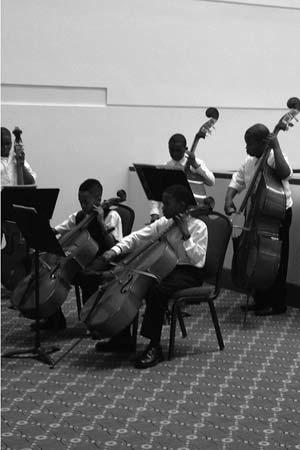


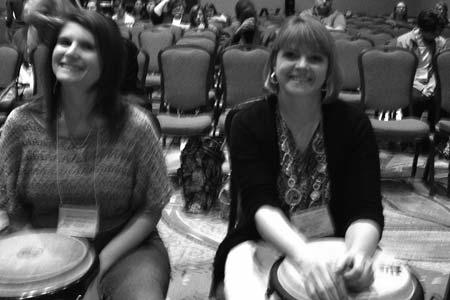





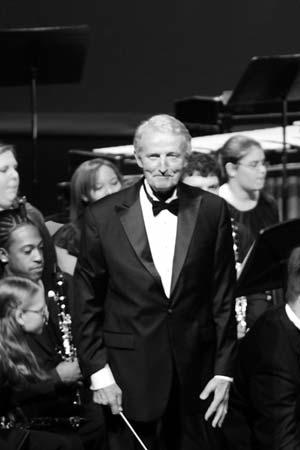
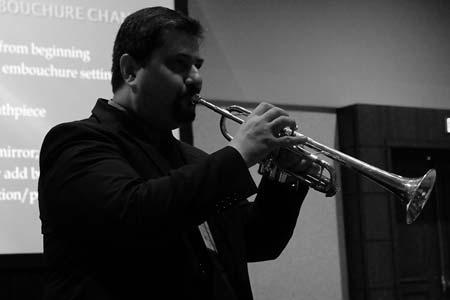
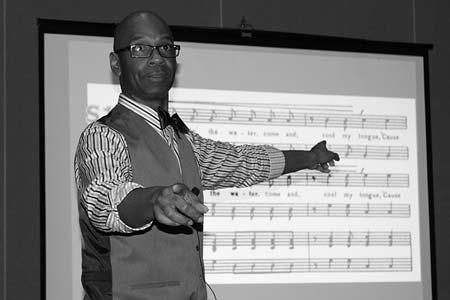
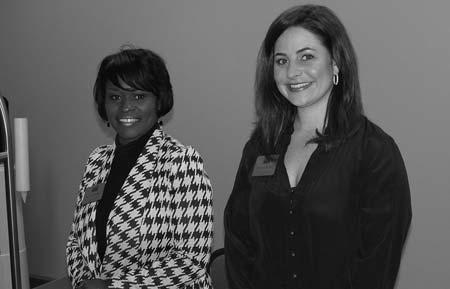

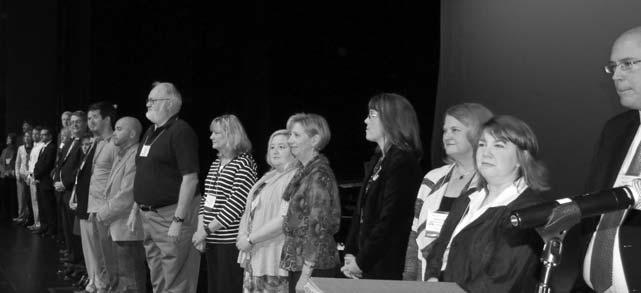

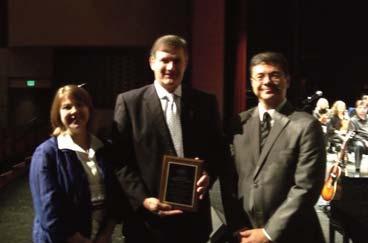





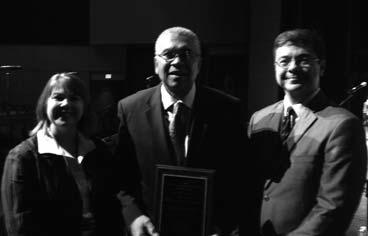



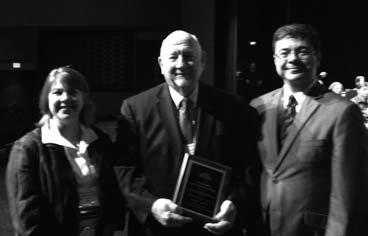

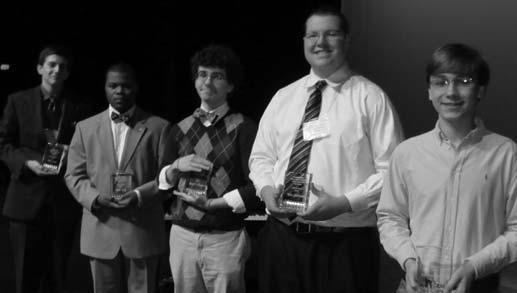


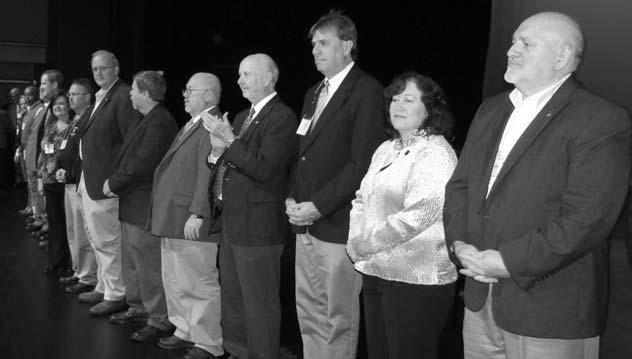



 Outstanding Administrator Dr. Vic Wilson
Outstanding Administrator Reba Caldwell
Outstanding Administrator Dr. Vic Wilson
Outstanding Administrator Reba Caldwell
AMEA In-Service Conference/All-State Jazz Band
January 10-12, 2013 - Renaissance Montgomery Hotel at the Convention Center
All-State Solo Festival
April 17, 2013 - UAH, Huntsville
District I
District Fall Meeting
HS All-State Band Auditions
MS All-State Band Auditions
District Honor Band
State MPA (Huntsville) State MPA (Decatur)
Solo & Ensemble Festival
Solo & Ensemble Festival District Spring Meeting
District II
District Fall Meeting
All-State Band Auditions
District Honor Band State MPA
Solo & Ensemble Festival
Solo & Ensemble Festival
District III
All-State Band Auditions District Honor Band State MPA
Solo & Ensemble Festival
District IV District Fall Meeting
All-State Band Auditions State MPA (High School)
State MPA (Middle School)
District Honor Band
Solo & Ensemble Festival
Solo & Ensemble Festival District Spring Meeting
District V
All-State Band Auditions State MPA
District Honor Band
Solo & Ensemble Festival
Solo & Ensemble Festival
District VI
All-State Band Auditions
District Honor Band State MPA
Solo & Ensemble Festival
Solo & Ensemble Festival
District Spring Meeting
District VII District Fall Meeting
All-State Band Auditions State MPA
Solo & Ensemble Festival
Solo & Ensemble Festival
District Spring Meeting
District VIII
District Fall Meeting
All-State Band Auditions
State MPA
District Honor Band
Solo & Ensemble Festival
Solo & Ensemble Festival
All-State Band Festival
April 18-20, 2013 - Von Braun Center, Huntsville
Summer In-Service Conference
June 26-27, 2013 - Hampton Inn and Suites, Orange Beach
August 27......................................UAH University Center
January 25.....................................................Sparkman 9th
January 26.....................................................Sparkman 9th
February 8-9...................................Bob Jones High School
February 21-22..............................................Huntsville HS
March 14-15......................................................Decatur HS
April 6...................................Meridianville Middle School
May 3..............................................Priceville High School
May 13...........................................UAH University Center
August 27.................................................Gadsden City HS
January 19.......................................Southside High School
March 15-16..................................Albertville High School
February 27-March 1...............................Gadsden City HS
April 22...................................................Arab High School
May 4...................................................Oxford High School
January 26...............................Muscle Shoals High School
February 22-23.............................Russellville High School
March 5-7....................................................................UNA
May 4 ...........................................TBA
September 10......................................Hoover High School
January 26.................................Homewood Middle School
February 26-28.............................Homewood High School
March 5-7............................Hewitt-Trussville High School
April 5-6.......................................Homewood High School
April 23.....................................Homewood Middle School
May 4.............................................Bumpus Middle School
May 20................................................Hoover High School
January 26......................................Prattville High School
February 20-21..............................University of Alabama
February 22-23..................................District Honor Band
March 14........................................Prattville High School
April 23............................................................Tuscaloosa
January 26..........................................Opelika High School
February 22-23...................................Auburn High School
March 11-13.......................Benjamin Russell High School
April 6................................................. Trinity Presbyterian
May 4..................................................Auburn High School
May 16.........................................................................TBA
August 27....................................Spanish Fort High School
January 19.......................................Davidson High School
Week of March 11.................................Baker High School
TBA...............................................Semmes Middle School
May 4......................................Spanish Fort Middle School
May 6...........................................................................TBA
August 27.....................................................................TBA
January 26.....................................Troy Elementary School
March 6-8.......................................Enterprise High School
March 15-16...................................Enterprise High School
May 4.....................................................Excel High School
May 11..........................................Troy Elementary School
District I
Fall Workshop - September 7-8, 2012 - Location TBA
All-State Show Choir Auditions - September 27-28, 2012 - Wallace State, Hanceville
All-State Show Choir Auditions - September 29, 2012 - First Baptist Church, Montgomery
All-State Auditions (You may register at any site)
November 1, 2012 - St.James, Montgomery
November 2, 2012 - Spring Hill Baptist Church, Mobile
November 4, 2012 - Florence Middle School, Florence
November 5 & 6, 2012 - Mayfair Church of Christ, Huntsville
November 7, 2012 - Mt. Zion Baptist Church, Alexandria
November 8 & 9, 2012 - Site TBA, Birmingham
All-State Show Choir Festival at AMEA Conference - January 10-12, 2013 - Renaissance Montgomery Hotel
All-State Festival - March 6-9, 2013 - Samford University, Birmingham
OA, OCS, & Music Ed Scholarship State Choral Performance Assessment
District II
District III
District IV
OA, OCS, & Music Ed Scholarship State Choral Performance Assessment Spring Solo & Ensemble
OA, OCS, & Music Ed Scholarship State Choral Performance Assessment Spring Solo & Ensemble
OA, OCS, & Music Ed Scholarship State Choral Performance AssessmentSpring Spring Solo & Ensemble
District V OA, OCS, & Music Ed Scholarship State Choral Performance Assessment Spring Solo & Ensemble
District VI
OA, OCS, & Music Ed Scholarship Music Ed State Choral Performance Assessment Spring Solo & Ensemble
District VII Fall Solo & Ensemble OA, OCS, & Music Ed Scholarship State Choral Performance AssessmentHonor Spring Solo & Ensemble
November 29..........................................................................TBA
March 13-14....................................First Baptist Church, Decatur
April 4-5........................Willowbrook Baptist Church, Huntsville
November 29..............................Tuscaloosa County High School
April 4....................................................................................TBA
April 3-4.................................................................................TBA
November 29..........................................................................TBA
February 25-27.......................................................................TBA
February 25-27.......................................................................TBA
November 29...........................................Alexandria High School
April 5..............................................First Baptist Church, Oxford
February 28.....................................Jacksonville State University
TBA.......................................................................................TBA
March 1..................................Columbia High School, Huntsville
April 4-5........................Willowbrook Baptist Church, Huntsville
November 29..........................................................................TBA
March 15.......................................First Baptist Church, Tallassee
March 15.......................................First Baptist Church, Tallassee
November 15..........................................................................TBA
November 29..........................................................................TBA
February 21............................................................................TBA
February 21............................................................................TBA
September 28, 2012 Elementary Music Festival, Samford University, Rollo Dilworth Conductor
September 29, 2012 Joint AMEA/AOSA Fall Workshop, Deer Valley Elementary, Rollo Dilworth Clinician
November 14 – 18, 2012 AOSA Conference St. Louis, MO
January 10 – 12, 2013 AMEA Conference, Renaissance Montgomery Hotel and Convention Center
October 20, 2012 Collegiate Summit , University of Alabama
January 10-12, 2013 AMEA Conference, Renaissance Montgomery Hotel and Convention Center
January 10-12, 2013 AMEA Conference, Renaissance Montgomery Hotel and Convention Center
February 7-10, 2013 AOA All-State, University of Alabama
See page 17 of this issue for All-State audition dates and deadlines
At some point in the history of modern wind band instrumentation, the alto clarinet became a four-letter word. Looking back on articles in The Instrumentalist as early as 1947, one finds well-written pleas to bring back the instrumenti, as well as questions of whether it is even necessary in the modern wind bandii. The alto clarinet’s exodus from the wind band happened for a variety of reasons. The early alto clarinets available to bands were of less than desirable quality, with tuning issues and anemic sound. The expense and time of owning and maintaining an alto clarinet was and is beyond practicality for many bands. Finally, in an ensemble where we seem to be eternally seeking a sufficient number of accomplished clarinet performers, dedicating a student to the alto clarinet may prove impossible. While it is true that the latest models of the alto clarinet (as well as the recently revived basset horn) are quality apparatuses that overcome the earlier weaknesses in tone production and intonation that doomed the instrument, the heart of the matter is that these other practical concerns have chased the alto clarinet from our bands, and modern composers are simply no longer including the instrument in their scores. As a result, one is more likely to see an alto clarinet hanging on a wall as an objet d'art than in the hands of a high school or college band member.
Faced with the reality of a world without alto clarinets in our bands, what do we do when we meet a concert work that calls for the instrument? This is the much more practical concern that many of us deal with on the podium, especially when we program wind works published prior to 1980iii. Unfortunately, a common response is to treat the alto clarinet and its part as "optional," something that can be left out whether it's covered by other voices or not. This often leads to a sound that at best was not the original intent of the composer, and at worst omits important chord tones not covered in any other voice. However, with the knowledge of what to look for during score study, and a minimum of rewriting, these alto clarinet parts can be added to your clarinet and bass clarinet performers' parts. The results are rewarding for conductor, performer, and audience alike.
First of all, let us discuss how to rewrite an alto clarinet part into other clarinet voices. The two considerations one must weigh are range and tessitura. While a soprano or bass clarinet might have the
range to play certain excerpts from an alto clarinet part, the tessitura may not match the intended color in the original alto clarinet part. In its lower range, the alto clarinet's sound is reminiscent of the throaty, woody sound of the bass clarinet, while in its upper range, it more closely resembles the hollow warmth of the chalumeau register of the soprano clarinet. This chart demonstrates the appropriate target areas for rewriting voices within the alto clarinet's range.
As demonstrated in the chart, the ranges of the bass clarinet and soprano clarinet overlap in multiple areas (green), and both can be used to replace an important alto clarinet part. The part chosen as the target for a rewritten line will depend on the ability of the performer - and therefore the technical difficulty or exposure of the part - and the desired color. The lower range of the soprano clarinet provides a warm, full sound, while the upper clarino registers are clearer and brighter. The bass clarinet is reedier yet warm in the middle register, and becomes increasingly plaintive and sweet in its clarion register. The conductor must evaluate these color changes when choosing which instrument will receive the rewritten alto clarinet part. A mixture of rewrites in the soprano and bass clarinets will often be the result. The orange highlighted areas feature pitches in which particular care should be taken, as these throat tones may prove challenging, especially when weaker players are given the rewritten part. Of course, practical concerns of who is available to perform a rewritten part will need to be considered. For example, if you only have one bass clarinetist, that performer will be busy with their own important lines, and therefore unable to perform many alto clarinet rewrites).
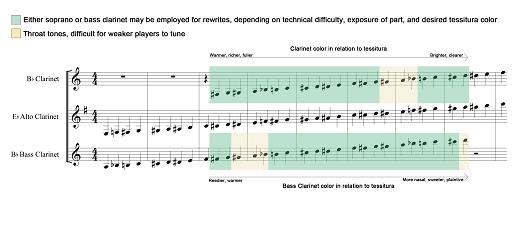
Knowing how to look for important alto clarinet parts during your score study can help pinpoint those times when a rewrite is required. This can be challenging, as a large scale work that includes an alto clarinet part often features such a plethora of staves that a unique alto clarinet line can be visually "lost in the shuffle." Also, there are many works and sections of works that simply double the alto clarinet with the bass clarinet, predisposing us to ignore this line. Because of these issues, one of the first steps in your score study should be a thorough inspection of the alto clarinet staff. Look for alto clarinet lines that contain chord tones that are not in any other clarinet part, or lines that double another part in octaves. Finally, look at the areas where the alto clarinet part is exposed while doubling another one or two instrumental parts at the same octave. This is an important color shading that should not be treated as optional.
All of the rewrite examples in this article will be taken from Warren Benson’s The Solitary Dancer and Darius Milhaud’s Suite Française. These works were chosen because they are from composers who have contributed multiple and lasting entries to the wind literature, because they are playable by accomplished high school and undergraduate ensembles, and because this author has put the rewrites into performance practice with his own ensembles. The excerpts given as examples are representative, and by no means the only alto clarinet rewrites necessary in the works discussed.
Warren Benson's The Solitary Dancer features an extremely important alto clarinet voice, creating marvelous open fifths with the bass clarinet, and generating important chord tones not doubled in any other part. The work is truly incomplete without the alto clarinet line. For example, in measures 43-45, a C-minor sonority would be completely absent if not for the alto clarinet’s Eb concert. Designating a third clarinetist to perform this pitch will complete the harmony.
measure 12 features a jaunty descending line of open fourths and fifths in the clarinet choir. The first soprano clarinet and alto clarinet lines are in parallel octaves. While the alto clarinet’s pitches are covered in other instruments and other octaves, omitting this voice leaves a hole in what would be a solid span of a perfect 15th. Placing one or more of the third clarinetists on the alto clarinet line repairs this gap in the sonority.

Later, at measure 65, the alto clarinet generates an important open fifth dyad with the bass clarinet part. This open fifth can be rewritten into either a bass clarinet or soprano clarinet part, depending on available performers.

Even when the alto clarinet's pitch is found elsewhere, rich clarinet choir writing that is missing one voice simply does not achieve the composer's intent. For example, the fourth movement of Darius Milhaud’s Suite Française, “Alsace-Lorraine,” features an exposed clarinet choir choir at measure 55. Though the bassoon 1 and clarinets 2 and 3 take turns covering the pitches in the alto clarinet line, the composer’s clear intent on the page is a clarinet choir; the Eb soprano, all three Bb soprano parts, the alto clarinet, and the bass clarinet are all included in this beautiful, exposed moment. The alto clarinet part is too low for a soprano clarinet to cover, so one bass clarinetist must be assigned to play this rewrite.

Sometimes the alto clarinet part doubles another line in octaves, and this is an extremely important sonic quality to preserve, as parallel octaves are a distinct color and texture all their own. For example, in the third movement of Milhaud’s Suite Française, “Ile de France,”
Finally, though you may find the alto clarinet part doubled at the same octave in another voice, the missing clarinet color resulting from ignoring this part can negatively effect the tone quality of your ensemble. This is especially true when the alto clarinet part is only doubling one or two other instruments in an exposed line. For example, Milhaud's Suite Française features gorgeous alto sax lines, especially in the second movement, "Bretagne." These motives are doubled (not cued) in unison by the alto clarinet. While the alto saxes are indeed covering this part, the alto clarinet softens and warms their timbre. Omitting this clarinet voice leads to a brighter, reedier sound that is simply not up to Milhaud's original vision. This necessary rewrite is demonstrated in two areas of the second movement - measures 25 and 36. The same motive is stated by the alto saxophones and the alto clarinet at these two measures, though at different pitch centers. Adding a clarinet voice softens and warms the sound of this line.
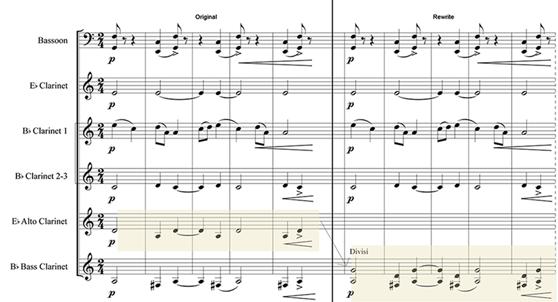
At measure 25, the soprano clarinet voice is resting and available, and the register provides an excellent match in timbre to the original alto clarinet part. In addition, the bass clarinet is occupied with a low E concert.
At 36, the motive is stated up a fifth. At this time, the bass clarinet is available to perform a rewrite, and the soprano clarinet would be
trapped in a mire of throat tones that would not lead to a desirable sound. Placing the motive into the bass clarinet is more practical, and generates a wonderfully sweet and plaintive sound.

important alto clarinet lines, and then rewriting those lines that fall into the categories listed above, will yield a significant and audible improvement in an ensemble’s performance.



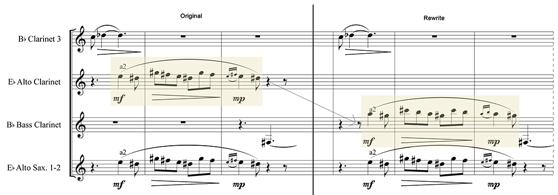
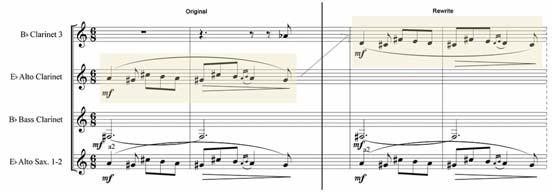
i Sawhill, Clarence E. WOODWIND: Problem of the Alto Clarinet, the." The Instrumentalist, 47, 1947. 8.

ii Rohner, Traugott. WOODWIND: Shall we Eliminate the Alto Clarinet?" The Instrumentalist, 47, 1947. 30.
iii Mark Wolbers, “Alto Clarinet: The Endangered Species of the American Band,” paper presented at Annual Meeting of the College Band Directors National Association, University of Washington, Seattle, December 23-26, 2011), PDF file, http://depts.washington.edu/uwwinds/cbdna/wordpress/wp-content/uploads/2010/ 10/A.%20Cl.%20Paper.pdf (accessed December 28, 2011).









While it is highly likely that the alto clarinet will never permanently return to most of our bands, it is important that we not ignore the scoring for this important voice in the earlier wind band literature. As with any other instrument in the ensemble, it was and is an important timbre. We can still provide this voice through other clarinet voices. Taking a moment to scan your score for these
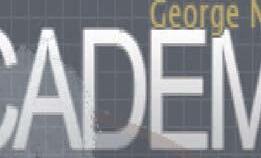
Ward Miller, the University of South Alabama’s first-ever Director of Athletic Bands, earned his doctorate in band conducting at the University of Iowa. He is the Director of the Jaguar Marching Band and the Jaguar Pep Bands. He is the Director of the USA Symphony Band, and the Associate Conductor of the USA Wind Ensemble. In addition, he teaches the Marching Band Techniques and Brass Methods classes. He also teaches beginning level conducting, and assists in coaching the trombone, tuba-euphonium, and brass quintet ensembles. He received his master’s degree in music performance from Arizona State University in Tempe, Arizona and his bachelor’s degree in music education from Auburn University.

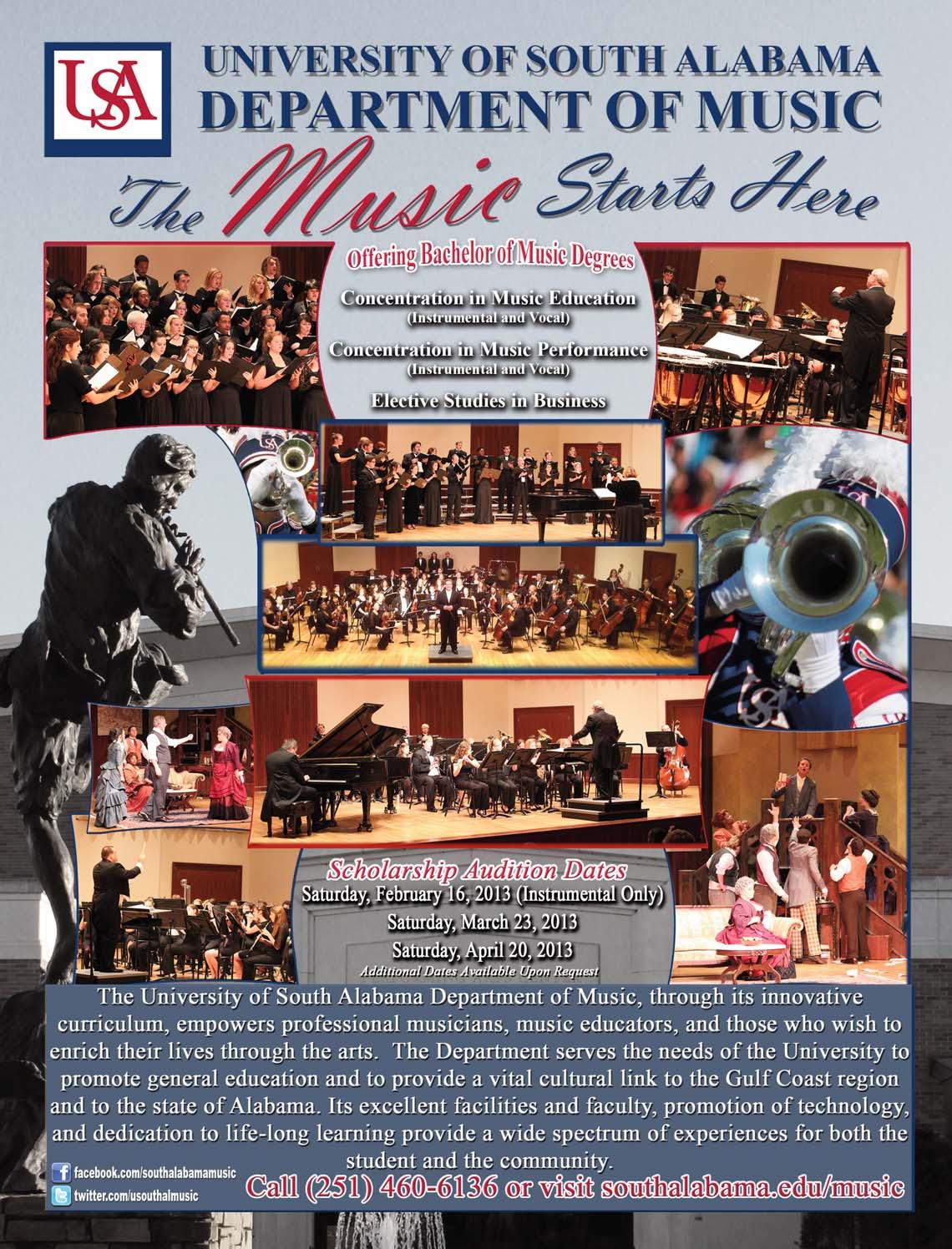



The St. Paul’s Episcopal School Chamber Strings from Mobile, AL departed the United States December 27th, 2012 for a ten day performance tour of Austria and the Czech Republic. The trip was presented through Music Celebrations International. While loaded with numerous sightseeing adventures the focus remained on three performance venues in Bad Ischl (outside Salzburg), Vienna, and Prague.

Of particular note was the Vienna performance where the group performed in the Orangerie of the Schönbrunn Palace, the summer home of Habsburgs where Wolfgang Amadeus Mozart and Antonio Salieri famously competed for a commission from Emperor Joseph II.
Helmut Wondra, Central and Eastern Europe concert manager for MCI observed after this performance: “The young musicians from the St. Paul’s Episcopal School were not intimidated by the audience of about 300 people who came to see and hear them perform – in contrary: they played with much energy and passion and it seemed that the venue and the enthusiastic crowd motivated them to perform especially well. The audience was delighted by the concert and generously gave donations generated through this concert for the sake of helping the street children in Arad, Romania. Congratulations to the St. Paul’s Episcopal School Chamber Strings and to their director Holly A. Compton for the musical excellence which they have shown in Vienna. We would be happy to welcome you back!”
Director Holly Compton was awarded a certificate honoring the group and marking January 2, 2013 for their contribution to the European Cultural Initiative for the Young Generation. The acknowledgement was presented by Dr. Jutta Unkart – Seifert, renowned Austrian soprano and President of the organization. The declaration states:” In the spirit of artistic excellence and intellectual engagement, you have contributed an important element to the global network of culture, peace and mutual respect between the world’s peoples. It is a necessity of our times to encourage in the younger generation a commitment to dialog. We each hold in our hearts and hand the imperative to contribute to a culture of understanding. Music, especially, speaks the clearest and most poignant language of reconciliation and every musician must be aware that he or she bears this honourable responsibility.”
After the Orangerie performance, the ensemble was honored at the home of Dr. Juntta Unkart-Seifert with a lavish dinner and a lecture from Professor Kudlak, a 30 year veteran of the Vienna Philharmonic.
The group also performed in Hlalhol Hall in Prague, one of the purest and most prominent art nouveau monuments of its kind. It boasts numerous original busts of directors who called Hlahlol their home base and enjoys being ranked amongst the most beloved Eastern European monuments of
Just outside Salzburg, the Chamber Strings performed in the spa town of Bad Ischl at Trinkhalle. The youngest of the three venues, Trinkhalle was constructed in 1928 originally as the “Soolenbadhaus” spa. Decades later it was altered and extended and has become a fixed part of cultural, and social events in the town.

AVA President Jody Powell accompanied the Chamber Strings throughout the trip. Mr. Powell reflected: “ Two times I have had the opportunity to travel internationally with the St. Paul’s Chamber Strings. Having seen them perform in London, England in 20082009 at St. John’s Smith Square and the Westminster Concert Hall, where under the direction of Holly Compton, they were exquisite. Also this past Holiday Season of 2012-2013 in Austria at Bad Ischl, in the Emperor Franz Josef Hall, in Vienna in the Orangerie, and in Prague, Czech Republic at Hlahol Hall. They are disciplined and dynamic, and bring an interpretation through a various choices of music, and a stage presence beyond that usually witnessed with this age. I am proud to be a faculty member of a school that supports the Fine Arts such as this.”
Despite an extensive performance agenda, the group was afforded many opportunities for tourism and to blend with the Austrian and Czech Republic cultures. Upon arrival in Munich, the group was transported to the town of Dachau and visited the Concentration Camp and Memorial Site. Salzburg sites included Mirabel Palace and Gardens, Mozart Square, the Dom Cathedral, University Church, Mozarthaus (Mozart’s Birthplace), a cable car ride up to the cities Fortress, the Salt Mines in Hallein, Mondsee church (the site of “The Sound of Music” wedding), and world famous Melk Abbey.
In Vienna, the group experienced a modern interactive sound museum, Haus der Music which
includes the museum of the Vienna Philharmonic Orchestra. They toured the Ringstraube, the Imperial Palace, State Opera, Town Hall, Burgkapelle (venue for the Vienna Boys Choir), Palace Stables, Strauss Monument, and a full guided tour through Schönbrunn Palace. A visit to the Central Cemetery provided the opportunity to pay homage at the graves of Beethoven, Brahms, Schubert, Strauss, and the Mozart Memorial.
Students and chaperones alike enjoyed a festive New Year’s Eve in Vienna, taking in all aspects of the culture including food, music, and dance. A spectacular fireworks display was captured at the stroke of midnight at Hero’s Square on the lawn of the Imperial Palace.
A highlight of the Prague visit was the Dvořák museum which included his piano on which most of his compositions were written, and his viola. The guided tour also
included the Charles Bridge, St. Nicholas Church, Old Town Square, Municipal House, St. Agnes Convent, the Jewish Quarter, Hradcany Castle, and St. Vitus Cathedral.
Violinist Carson Blaylock is a senior at St. Paul’s Episcopal School who has performed in numerous ensembles under Holly Compton for seven years. She shared some of her feelings after the trip: “Performing in the Orangerie of the Schönbrunn Palace is an experience which I will never forget. Knowing Mozart and Salieri engaged in a musical duel in the same room centuries ago, I felt a new sense of inspiration.”
Founded by Holly Compton in 1990 in Mobile, AL, the Saint Paul’s Episcopal School Chamber Strings perform extensively throughout Mobile, AL and surrounding areas. In 2001 the ensemble opened the Field Studies International Choral Festival where they made their
Carnegie Hall debut. The group realized their first international exposure in 2004 with a performance in St. Patrick’s Cathedral in Dublin, Ireland. In 2008/09 saw performances in London, England both at Westminster Central Hall and St. John’s Smith Square where they were described as: “Disciplined and dynamic, bringing an interpretation through choice of music, and a stage presence beyond that usually witnessed with this age.” The group is comprised primarily of students ranging from age 14 – 18.
To enjoy more stories and photographs about St. Paul’s Episcopal School Chamber Strings performance tour of Austria and the Czech Republic: www.stpaulsmobile.net → Fine Arts→ String Orchestras.
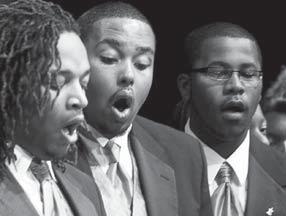

For the first time in its history, the University of North Alabama Pride of Dixie Marching Band performed for the Bands of America Marching Band Super Regional Fall Championship in Atlanta, GA on October 27, 2012.
The band represented the University of North Alabama and the Shoals area by performing three performances for an audience of more than 10,000 high school students, parents and band directors. The Pride of Dixie was invited to perform because of its demonstrated standard of excellence throughout the years.
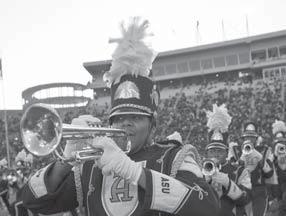
During this nationally sanctioned event, outstanding high school marching bands competed in one of the nation’s most prominent marching band championships, Music for All’s Bands of America (BOA) Regional Championship at the Georgia Dome in Atlanta, GA. The 34+ high school marching bands performed in preliminary competition, evaluated by a panel of

nationally recognized music educators and marching band experts.


The University of North Alabama Pride of Dixie Marching Band demonstrated its excellence, professional sound and clean, crisp marching maneuvers for this highly competitive audience.
Music for All’s mission is to create, provide and expand positively life-changing experiences through music for all. Music for All’s vision is to be a catalyst to ensure that every child across America has access and opportunity to participate in active music making in his or her scholastic environment.
It was a great honor for the University of North Alabama Pride of Dixie Marching Band to be featured during this event.
UNA Director of Bands Dr. Lloyd Jones commented, "The directors and students of the Pride of Dixie were thrilled to represent Alabama as the exhibition band at the prelims, opening ceremony, and finals of the Bands of America Super Regional in the Atlanta Georgia Dome." "The students worked diligently to present a performance that would be of a professional caliber and represent our University and Alabama's instrumental music education community in a positive manner."

We spend our days doing good things. In our haste to move forward, we often pass up the opportunity to reflect on a job welldone. Author and speaker Roger Hinkins said, “Increasing your self esteem is easy. Simply do good things and remember that you did them.” It’s good advice to us as individuals. It’s also good advice for us as an organization.
AMEA has been doing good things for kids since 1946. Look at that list of past presidents which appears in each issue of Ala Breve, and you see names of people who helped shape the direction of music education in this state. Every year, we recognize the Outstanding Music Educator, Outstanding Administrator, and Barbara Odom Award winners, and those awards are reported in Ala Breve. When those awards are bestowed, we are applauding people we know. We have heard their groups. We have seen the results of their work.
But time passes, and if we are not careful, our history gets away from us. Those entering our profession will only know of what has gone before if we preserve it today. That’s what this article is all about.
When Dr. Sara Womack asked me to take on the role of AMEA Historian, I gladly accepted. Some specific short-term plans are underway. In the not-too-distant future, we will have a page on the AMEA website with the picture and short bio of every former AMEA President. We will also have a list of past recipients of the Outstanding Music Educator Award, Outstanding Administrator Award, and Barbara Odom Award.
Researching old issues of the Ala Breve and talking with numerous people has
provided much information, but there is more to gather. The more years which have passed, the harder it becomes to gather that information.

The term “crowdsourcing” was coined in 2006 in an issue of Wired magazine. It involves finding answers through an “open call” to a large body. Its results echo the truth of the Japanese proverb, “None of us are as smart as all of us.” To help me fill in the remaining holes, I am using crowdsourcing—asking for your collective help with the bits of information you may have.
Specifically, I am trying to answer these questions:
Who was awarded the Outstanding Music Educator Award for each of the following years: 1984, 1986, 1994, 1995, 1997, 1998, 1999, 2000, 2001, 2002, 2003, 2004, 2005, 2006, 2007, 2008?
Who was awarded the Outstanding Administrator Award for each of the following years: 1984, 1986, 1990, 1991, 1993, 1994, 1996, 1999, 2000, 2001, 2006?
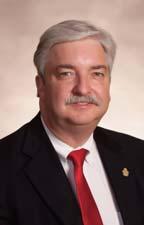
Who was awarded the Service Award, later renamed the Barbara Odom Award, for each year from 1988 through 2002?
Can you provide information, or contact information for someone who can for the following AMEA Past Presidents: Walter A. Mason (1948), John J. Hoover (1952), S.J. Allen (1976).
If you, or a colleague, was the recipient of one of these awards in a needed year,
please email me at Frank@FrankBuck.org and let me know.
Another arm of the project being undertaken is compiling Alabama State Band Competition Festival programs and ratings from its inception in 1947 through our present-day Music Performance Assessment. In 1974, as a 9th grader who aspired to be a band director, I began making it a point to secure a program each year and copy into it the ratings from State Contest. At the point where I realized my records were more complete than what ABA had archived, I began trying to secure this information from 1974 back as far as I could go. Right now, I am all the way back to 1952.
Some holes remain. For some years, I have final ratings, but am missing ratings from individual adjudicators. For some, I am missing ratings from a particular day of the festival. Again, I am turning to “crowdsourcing” to fill in the holes. Visit http://bit.ly/StateContest (case sensitive, no spaces) and view exactly what data is still missing and how you may help.
At the point where we have gathered as much information as is possible, and the search process is considered “finished,” the plan includes duplicating all of the programs, scanning them, and posting it all on the ABA portion of the AMEA website. Everyone will be able to see schools, directors, program selections, and ratings back through the history of this event.
We do good things. Remembering we did them just might be the key to even better things ahead.
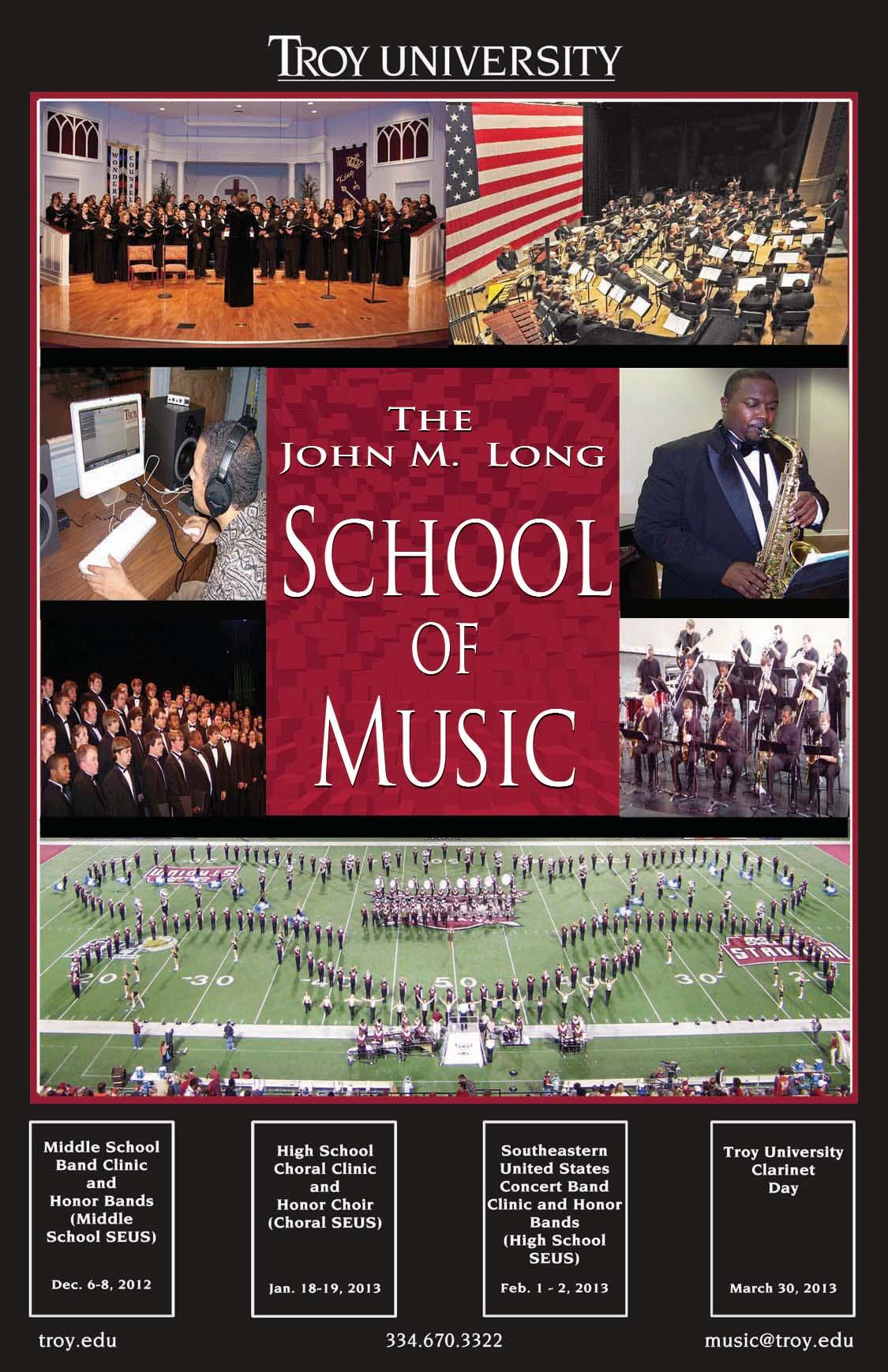
This past summer while visiting my parents, I was given some papers that contained genealogical information that one of my distant cousins had assembled. Most of the names on the list had no relevance to me; there were a few that did. In one little branch of this genealogical chart, I was able to trace my heritage back to one pair of my great-great-great grandparents. That was the first time I had ever seen these names, but it struck me at that point that these were just two of thirty-two great-great-great grandparents that I had. I also realized that I would most likely never know anything more than names and dates for that generation of my family.
I then began to consider how my descendants might eventually look at information regarding me, and it became very clear that they will know far more about my generation than I could ever dream of knowing about my forefathers.
With the amount of information that we are posting to the internet, it is completely possible that our descendants will be able to not only find out important dates, but they will probably be able to view photographs and videos of us. In fact, it seems possible that they might even be able to read our inane and mundane comments from some of the various social media sites.
The thought that was most present in my mind was that as we are collecting all of this information, we are also cataloging many of our musical performances. There was a time not too long ago in which it was difficult and quite expensive to produce a professional recording. The only people who were recorded were either so famous that people demanded recordings or they were able to put together enough money to produce the recording themselves. We now have the ability to post a concert to a
Dr, Grant Daltonwebsite like YouTube within just seconds, and all that is needed is a smartphone. We now can capture and catalog musical moments that might seem rather unimportant at the time, but they are, nonetheless, preserved for posterity. I find this possibility both exciting and a bit intimidating, but it has provided me with another reason to practice harder and expect more from my students. Who knows who will be watching those performances in future years? It might just be my great-great-great grandchild. Or yours.
Dr.Grant Dalton is the professor of percussion studies at Samford University where he directs the Samford Percussion Ensemble and Samford Steel, the university’s steel drum band. He is also the assistant athletic band director and teaches several academic courses.
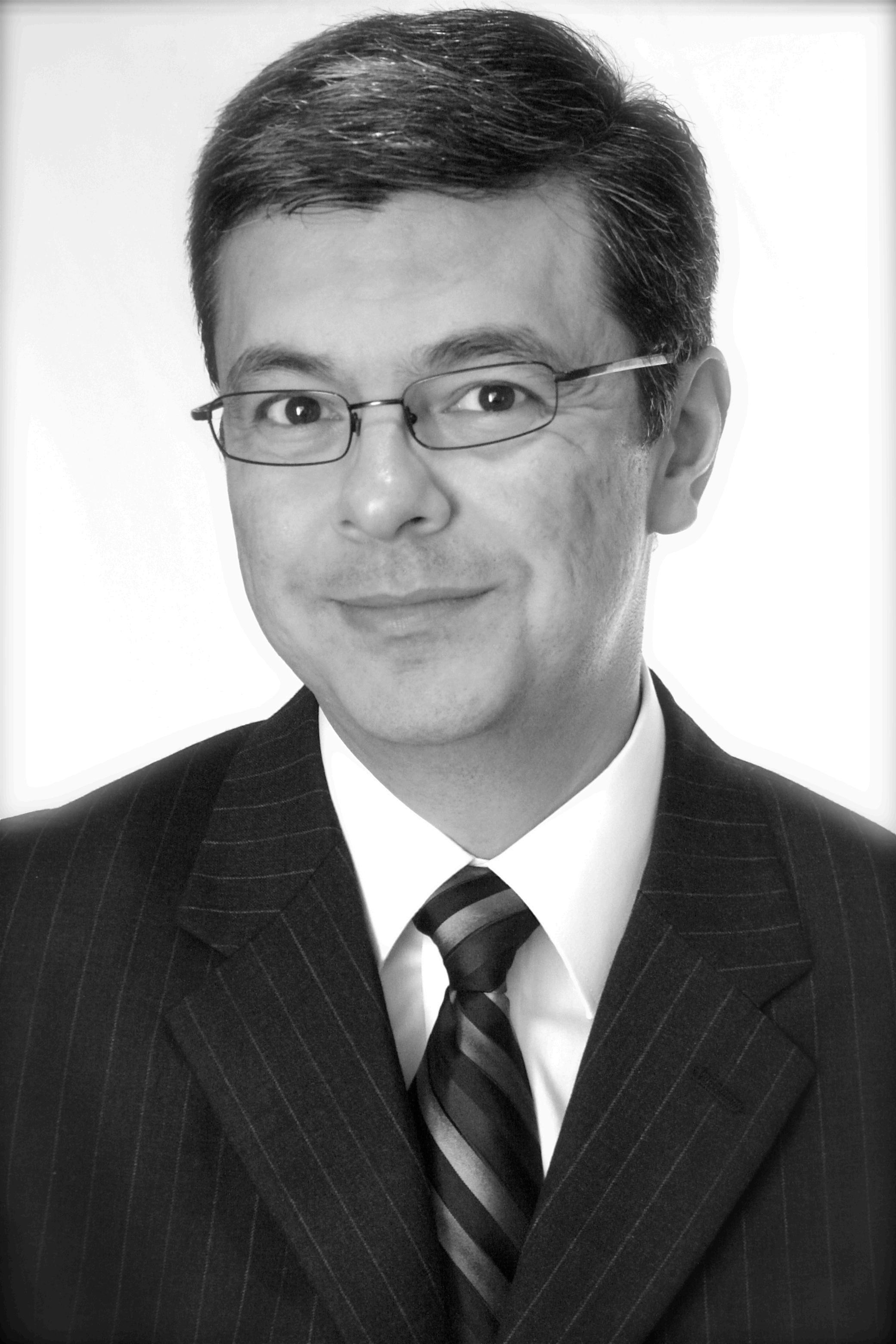
Several years ago, Cornelia Yarbrough suggested that good teaching might be in sonata form 1 . Indeed, it seems that effective instruction tends to follow a basic three-part pattern, often referred to as a complete teaching cycle, comprised of 1) teacher presents a task, 2) students attempt to perform the task, and 3) teacher provides accurate corrective feedback along with approval or disapproval2. When conductors use complete teaching cycles they tend to profoundly affect their students’ sense of accomplishment, enjoyment of the subject matter, and perception of teacher competence over conductors who attend only to the first two parts of the cycle 3 While this explanation of teaching cycles is grossly oversimplified, today the importance and influence of the third part of the cycle––accurate and immediate corrective feedback––is widely recognized as a fundamental tenet of good instruction.

Unsurprisingly, it is almost impossible to be a good teacher without giving feedback on a regular basis. A student plays a heartfelt solo and we smile in approval, another student identifies the correct diminished chord and we award five points while nodding our head in affirmation, still another helps a friend pick music up off the floor and we say thank you for thinking of others. While giving accurate feedback to students is important to effective teaching, effective teachers also seek out opportunities to get feedback from their peers. For example, secondary music teachers regularly have their students participate in music festivals, competitions, and assessments where professional adjudicators offer advice, commentary, and rate the performance using standardized measures. Many of us invite trusted colleagues to visit our schools, conduct our groups, and provide unmitigated advice in exchange for a cup of coffee or barbecue dinner.
Honest and useful feedback is important to our professional and personal growth. When feedback is positive, immediate, and accurate it affirms that things are on the
right track and that others are pleased with our work. When feedback consists of constructive criticism or is negative we have an opportunity to improve, try a different approach, and determine whether we are headed in the right direction.
In the last issue of the Ala Breve4 , I shared that the Governing Board traditionally solicits feedback about the annual Alabama Music Educators Association In-Service Conference and that for the 2013 AMEA Conference the board voted to add an additional level of feedback––assessment of individual clinic sessions. The reason behind the addition was simple, clinicians spend many hours preparing their presentations and it seemed right to provide them with feedback directly from attendees. At the same time, we wanted to give AMEA members the opportunity to comment on the sessions and establish a line of communication with the clinicians.
To accomplish this task, we developed the Conference Evaluation Portal, which allowed AMEA members to use their smartphones, tablets, or computers to select a conference session, evaluate it, and have the evaluation sent directly to the clinician by email. A link to the evaluation form was placed in the conference Guidebook App for attendees to use.
After the conference, I emailed the clinicians to solicit their thoughts on the immediate feedback they received. In general, our clinicians were very appreciative of our evaluations. They especially liked how quickly they received feedback and praised the evaluation system. Here is a sample of their comments:
“First, let me say that I have been raving about the conference's feedback method to colleagues this weekend. Your conference is the very first that I have received near instantaneous feedback for something like
this. I think the concept is fantastic--it allows all those with smartphones to comment while it is on their mind, and the fact that it goes immediately to the presenter is very helpful.”
“The conference session feedback system was wonderful. We received feedback within minutes of the session wrapping up. I wish all conferences used this system! Thank you for being willing to experiment...I hope it is used from here on out”

At the same time, not everyone was comfortable with the immediacy of the feedback, one clinician, who received much praise and admiration from attendees, offered the following suggestions and thoughts:
“Regarding the feedback, it was a little disconcerting to get random emails about my session/performance....I think it would be better to somehow get all of the feedback in one message...I was sort of apprehensive about reading them as they arrived. Doing a session really is a lot of work, receiving ongoing critiques after the fact is a bit uncomfortable, and may be discouraging. I am wondering if just the planning committee needs to review these evaluations and then maybe keep the feedback in mind for future planning.”
Most clinicians shared that they really appreciated our comments and suggestions for improvement.
“The response to my session was overwhelmingly positive and encouraging, and the quantity of it, I believe, was directly attributable to the ease of the system....Please continue to use it, and thank you.”
They also gently encouraged conference attendees to provide more written comments...
“The short answer questions were particularly helpful when people completed them, but I know they take more time for the participants to fill out...”
con’t on page 45
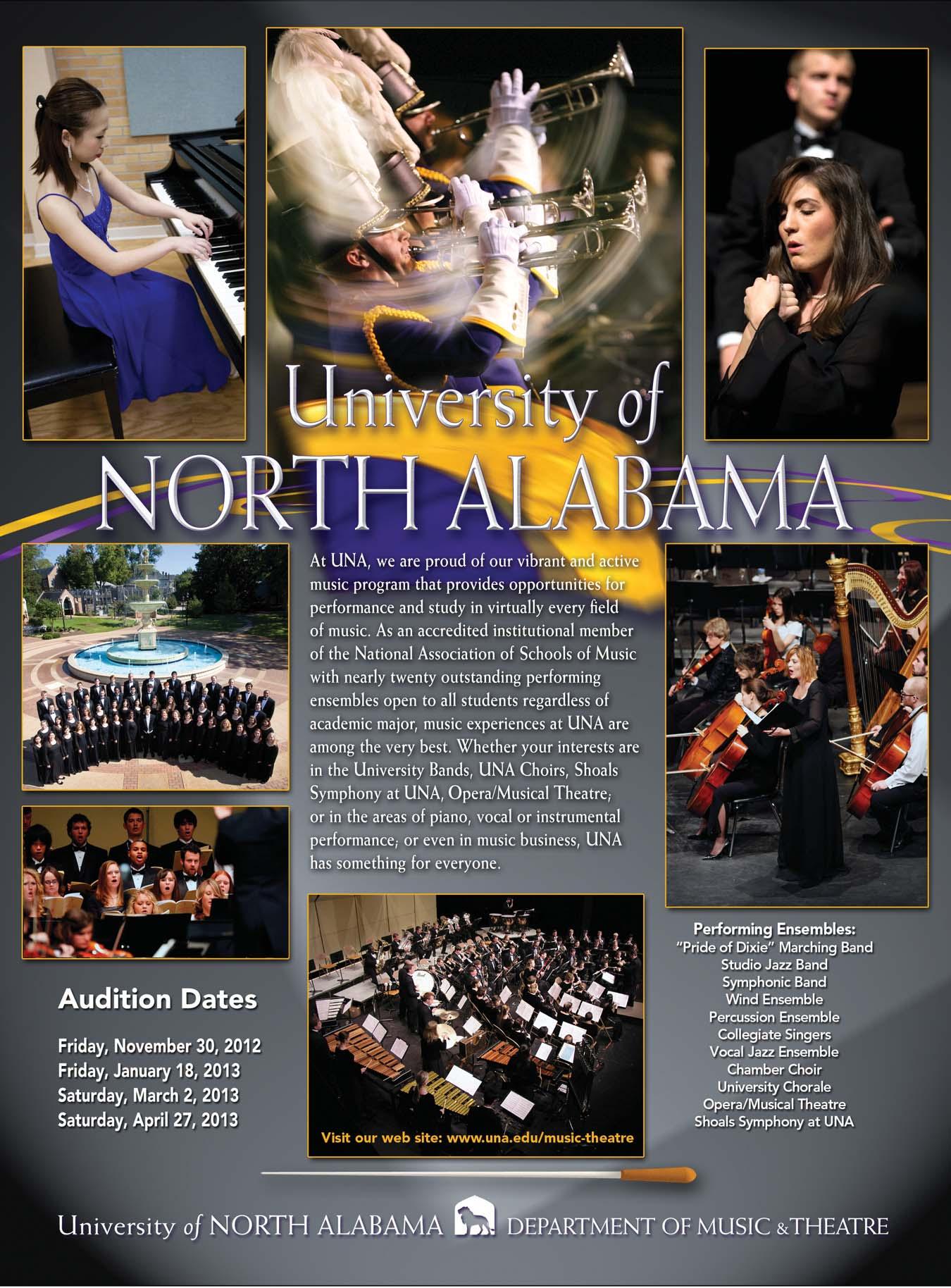

The following was created by compiling all of the feedback our clinicians received from us into a single report. As you will see, our clinicians did a very good job presenting.
Results from the first portal question revealed that over 78% of us attended a clinic session that was either outstanding or very good
example, concrete illustration, or hands-on activity can help us understand an idea more deeply. Most of us (81%) rated a clinician as either outstanding or very good in the use of examples.




handouts with plenty of space for notes, thanks!
The second portal question asked us to determine if current information was presented. Obviously, all of us attend conference sessions to learn about new practices, ideas, and techniques. Approximately 80% of us attended a clinic that was either outstanding or very good in the use of up-to-date materials and methods.
Finally, the overall impression of a clinic session is extremely important for us to evaluate. According to our evaluations over eighty-one percent of us attended a session where they found the quality of the content to be either outstanding or very good.
Suggestions for improvement. Try to provide more hands-on activities, relate content to the needs of Alabama music teachers, try to demonstrate concepts with an ensemble, relate materials to teachers of all levels, schedule more time for this session, attendees couldn’t hear the clinician, please use a microphone in large rooms, provide a handout, provide more handouts, use an electronic handout to save paper, setup equipment before the session begins, provide more time for questions, session needs a larger room to accommodate attendees, provide a door prize, please place the clinicians on a platform so everyone can see them.
In general, most attendees were very pleased with the content of the clinic sessions, which bodes well for the clinic selection process used by the AMEA Governing Board and the efforts of our presenters. Using the Guidebook App as a platform to access the conference evaluation system worked very well and my thanks goes out to Executive Director Garry Taylor for hosting the Conference Evaluation Portal through the app.
When attending a clinic at the AMEA Inservice Conference, we expect our clinicians to present a session that coincides with the description found in the conference program. Over 84% of us attended a session where the presenter did an outstanding or very good job of presenting what they planned.
It is one thing to rate the quality of a conference session, but it is an entirely different matter to provide suggestions and commentary. Indeed, as a former band director, I really enjoyed the recorded and hand-written comments from my peers and in many ways valued their instructive statements so much more.
In general, there were many very positive and detailed comments about the clinic sessions. The following results were created by compiling all of the feedback and sorting it into cohesive categories. From this, we can see what our clinicians already do well and what we need to help them with for next year.

Friends, I think we have a really good system in place for collecting conference feedback in the future and I highly recommend using it again in 2014. On behalf of the clinicians and presenters this year, please accept our collective thank you for taking the time to provide your feedback!5
1 Yarbrough, C. (1987). Good teaching may be in sonata form. In C. K. Madsen & C. A. Prickett (Eds.), (Applications of Research in Music Behavior, pp. 3-11). Tuscaloosa, AL: The University of Alabama Press.
2 Yarbrough, C., & Price, H. E. (1989). Sequential patterns of instruction in music. Journal of Research in Music Education, 37, 179-187.
In-service clinic sessions should challenge attendees to think about their practice and discuss new ideas. However, sometimes an
Positive comments and praise. Wellpresented session, very experienced clinician(s), repeat this session next year, repeat this session every year, great story telling by the presenter, great application of materials to a variety of student levels, good use of a live ensemble, material was relevant, session was easy to understand, I can’t wait to try this, great presentation skills, excellent use of positive and negative examples, thanks for the free materials, very organized presenter, clinician provided
3 Price, H. E. (1992). Sequential patterns of music instruction and learning to use them. Journal of Research in Music Education, 40, 14-29.
4 Hancock, C. B. (2012, October/November). Gathering data: A brief report from the President-elect. Ala Breve, 10.
5 Full disclosure, I co-presented at the conference along with my friends Ken Ozzello and Justin Ward and of course we received feedback from all of you! The ol’ saying what is good for the goose is good for the gander certainly is applicable.
In 2013, Dr. Johnny Long celebrates 65 years as a band director in the State of Alabama. As Trojan fans know, Dr. Long brought “The Sound of the South” band into the national spotlight during his tenure as band director from 1965-1997. When he arrived on campus, he had 13 members in the band. When he retired, the band had over 300 members.
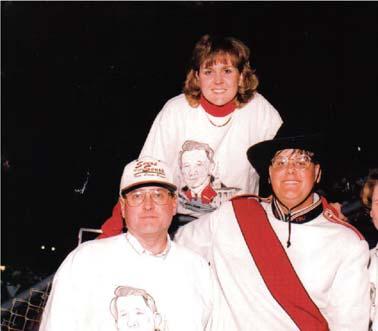
Along the way, Long served TROY as Dean of the College of Arts and Sciences and Special Assistant to the Chancellor under Dr. Ralph Adams. He also was instrumental in bringing the National Band Association Hall of Fame of Distinguished Band Conductors to TROY, and is one of the few living inductees in that illustrious Hall.
Into his seventh decade of teaching, he continues to receive new honors. In 2011, he was the subject of a profile on CBS Sunday Morning with Charles Osgood and The CBS Evening News with Scott Pelley. This led to his being chosen for the Stephen Sondheim Prize at the Kennedy Center in Washington, D.C., and recognition from President Barack Obama.
Two buildings on the TROY campus bear his name, and the School of Music is named for him. He has received just about every accolade a band director could ever hope for.
And yet, one of Dr. Long’s proudest accomplishments is the development of a special esprit de corps in the TROY band program that exists to this day: the Sound “family” has grown to extend far beyond any expectations.

Several band members came with Dr. Long from Robert E. Lee High School in Montgomery. Long founded the Lee Band and brought it to regional and national acclaim during its first ten years.
Rennie Mills, a member of the first Longera Sound of the South, remembers an early meeting with The Man. “I first encountered [Dr. Long] in 1959. I thought he was a madman. In 1962, I joined the Lee Band and realized he was teaching life lessons.”
Linwood Erb, who changed his mind about attending another state college to go to TROY.
“My first impression was one of awe. When I started band in seventh grade, my goal was to be in the Lee Band.”
Mills says that Dr. Long held his students to a higher standard, particularly when it came to attending classes. He recalls some of the early rehearsals as “hard work, long hours.
“The first year, we did the REX parade in New Orleans, Louisiana. We left at 4:00 on Monday afternoon, did the parade on Tuesday, left New Orleans at midnight, got back to Troy at 8:00 a.m., and he dared anybody to miss class!”
awesome experience.”
By Michael BirdAnother band member that first year was
Mr. Erb met his wife in the SOTS, and later, his children were also in the band. He recalls, “Troy University personally means everything to me. I met my future wife Linda while a member of the band. It also gave me the opportunity to make a living doing what I had always wanted to do in life, and that was being a band director … [my] proudest moment was when my wife Linda, my daughter Staci, my son Scott, and I marched at the same time during halftime at [the 1995] TROY Homecoming.”
Staci Erb Oliver, now a sixth grade teacher in Tallassee, remembers that experience, as well.
“When we started playing the ‘Fanfare’, chills went up my spine. That was an



Scott Erb, currently a manager of web product development for Compass Bank, says that the family playing together was “awesome! That was the first and only time we all played together. I will always cherish that moment.”

Tony Whetstone is another member of the Sound of the South family whose connections to the band extend across the years.
It didn’t start that way, as Whetstone had planned to attend Auburn University when he completed high school.However, a Friday night football game conversation with his former band director changed the direction of his life’s plans.
“Mr. Truman Welch, my high school band director, had just left Wetumpka High School for a position at TSU,” Whetstone recalls. “He said the band at Troy needed a bassoon player and thought scholarship money would be available. I spoke about [it] with my Mom, and she said it would be my decision. So, on a Monday morning in September 1972, my life took a new direction and I began my college days in Troy.”
Whetstone, like Erb, met his future wife marching in the Sound. “During band camp, I became interested in a pretty girl who was the French horn section leader,” Whetstone continues, “[and] I dated Rhonda Alford during that fall quarter. We were engaged in February and married in June.”
Rhonda and Tony Whetstone served Pike Liberal Arts School as band directors before taking on the band director jobs at Daleville High School, where they taught a shy blonde flute player named Amanda Bast – known today as Amanda Ford, band director at Charles Henderson High School in Troy, and wife of Ralph Ford, former Director of Bands at TROY University.
The next generation in the Whetstone family
carried on the Sound tradition, as well: son Gunter was a member of the drum line from 2002-2006. Tony Whetstone is currently the President of the Troy University Band Alumni Association, and Rhonda Whetstone is Assistant Principal at Destin Middle
There were times when the Next Generation had to endure stories about their parents – or themselves – being told to the entire band.
Scott Erb ruminated on this point, saying “My first week of band camp, Dr. Long starts telling a story to the whole band about how I used to be so small as a baby. Then, he goes on talking about how great my family is. This is a good way for everyone to start knowing you!”
Recalling his first impression of the unforgettable Long, he says, “I remember going into his office [when my sister Staci was in the band] and he had his shoes off and on his desk. I just laughed!”
Linwood, is filled with pride that his children could experience the Sound of the South and Johnny Long’s direction as he had – something which does indeed make the Erb family unique. “I am glad they [Staci and Scott] could experience all the things I had told them about Dr. Long and the band. Dr. Long was a father figure to me and has remained so over all these years. When he said something, you said ‘yes sir’ and did it. Forty-six years later, I still say ‘yes sir’ and try to do it to the best of my ability.”
Tony Whetstone says that the years attending Alumni Band functions “have been enjoyable and memorable”, as he and his wife attended football games, Southeastern United States Concert Band clinic events, tailgated, mingled, and performed.

School (Florida). “I often wonder where I would be and what direction my life would have taken if I had not attended that high school football game in Wetumpka on a Friday night in September 1972,” Whetstone recalls.

The SOTS often served as its own fraternity or sorority, with the bonds between the members becoming as strong as family ties.
“The band was my sorority. Everywhere I went on campus, I saw someone from the band. That made my first year away from home much easier,” Staci Erb Oliver remembers. “I also always enjoyed the concerts and battle-of-the-bands after the games. Dr. Long would always get former students, usually band directors, to conduct. And of course, my Dad would always direct a song. That was neat!”
Rennie Mills “did not push” his daughter Jennie to attend TROY, but “if you are going to major in Music Education, where else would you go?” he asks.
Jennie Mills serves as the official Music Librarian for “The President’s Own” United States Marine Band in Washington, DC. Her father is understandably proud of his daughter’s accomplishments in the world of professional musicians, but has a special memory. “I remember the first time I saw her in the TROY uniform, I got a little sentimental,” he says.
She remembers the stories, too: “I remember starting band camp my freshman year, and immediately Dr. Long begins the stories about the Erb family,” Staci Erb Oliver says.
There are literally hundreds of couples who met and married in the Sound of the South. And there are just as many who had siblings, parents, children, and other relatives become a part of the band program through its storied history. The list is just too numerous to mention.
So, what makes it all so special? And, more importantly, what keeps them coming back for Alumni Band events every year?
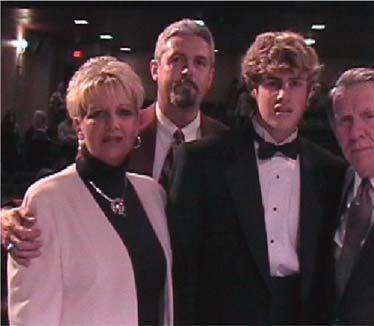
“I made some really great friends, and the band helped me to be a leader on-campus and off. Mr. Ford [the current SOTS director] hired me as their webmaster a couple of years ago, and this lets me give back to the band, being that I didn’t enter the profession of bandmaster like my father,” Scott Erb says. “And, I have had the honor of being in 29 weddings, which over 20 of them have been friends I made at TROY University.”
His sister Staci expresses a similar sentiment.“I think it is neat for my children to be able to see some of the things I did, and to see that music was/is an important part of my life,” she says. “My mom, dad, brother, husband, and I all attended TROY. Not many families can say that. We have a special connection to Troy, Dr. Long, and the Sound of the South!” Their father,
Rennie Mills helped organize the very first Alumni Band in 1981. Recently, he reminisced about the origins of the yearly get-together for band people at TROY.
“I had seen the Auburn alumni band and after talking with other Troy folks, approached [Dr. Long] about it, and he was all for it. I think we ended up with about 150 folks the first time we did it.” Mills recalls one special highlight – the 1995 Homecoming halftime where the Sound of the South family, past and present, was united in music for a special performance. “When Dr. Long retired, 505 alumni and 300-plus in the Sound of the South playing the ‘Fanfare’ together set the press box back about 10 feet!” Mills laughs.
The Troy University Band Alumni chapter serves to reconnect old friends, certainly, but serves a greater purpose, according to Scott Erb, a member of the Board of Directors.
“To keep the SOTS alive and kicking, we provide scholarships that help current band members pursue their education.”


Michael Bird is band director at Southside Middle School in Tallassee and is the webmaster for the Tallassee City Schools system. He is also a disc jockey on WACQ-AM 580 and FM 101.1, works at Super Foods of East Tallassee, serves as Financial Secretary of the Knights of Columbus, serves on the Board of Directors of the Troy University Band Alumni, and writes for the Tallassee Tribune newspaper. Michael is married to professional musician and New Orleans native Sena Thibodeaux Bird – a trumpet player in the Montgomery Symphony Orchestra, and has six children (five daughters and one son).


I am writing to let you know of good things that have happened with the New Hope and Owen’s Cross Roads Band programs. The band programs have a long tradition of excellence. In the past, they performed regularly at festivals and games. The community has been very supportive of the program. We are a small town located between Huntsville and Guntersville, in north Alabama. We are a community that has gone through transitions from a medium-size rural school to a smaller rural school. Large parts of our zone have annexed into Huntsville. The diminishing size and financial resources have taken their toll.
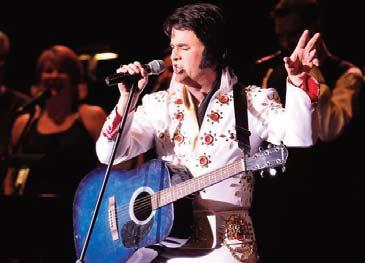
There are many good things about our school, community and music program. We have good students that are willing to work hard. They are talented and smart. The school is the center of the community. We have thousands of people at athletic events, hundreds at concerts and it seems like the entire population at parades. We have a good relationship with our elementary schools. Everyone wants what is right and strives to make it the best. The boosters are strong and active. They strive to help in every way they can. It is sometimes hard to get everyone to understand how much we have to offer. Previous teachers did a good job with fundamental music instruction and keeping the community behind the program.
The band program was lacking basic funding. Grades 6-12 were functioning on $7000-$9000 annually made from a football concession stand and a few fund raisers. Out of this, the band attended 10 football games, provided meals on game day, paid for buses, hired band camp staff, purchased music and paid other expenses. When one full-size tuba costs $5000+ and uniforms are tens of thousands, that amount of money does not go far. The lack of usable instruments had already begun to limit the possibilities for the band program. Eventually, the problem would have become overwhelming. We were making plans to overcome the shortfalls and plan for the future.
Then something unusual happened. A parent, Mitchell Brown, came to me. He had attended our meetings where we discussed what needed to be done to solve our financial problems. Mitchell was a product of our program. He graduated when the band and school were larger. He loves our community and these students. His son is in
band. His wife works in one of our elementary schools. I knew he had a great desire to help. I did not realize how much help he could be.
He asked about doing a benefit concert for our program. He explained that he was part of a group that did benefit concerts for charities every 4-5 years. He said that he would rent out our local civic center, rehearse with the orchestra, sell tickets, ask for donations from all over our area of the state, and give all of the profits to the band. It was a generous offer. They had raised tens of thousands for various needy causes. Then he said it was an “Elvis” show and he was an impersonator. My mind immediately went to the movies and the typical portrayal of such events. All I could see in my mind was a glorified night club act with several dozen in attendance.
by Michael Aycock, Director of Bands New Hope High School

would need. $30,000 fills the current instrument shortfalls, repairs many instruments, and may help us do something special. Now we may have options. With $24,500, the band has purchased the following instruments (new and goodcondition used): 2 convertible tubas, 2 convertible euphoniums, 2 French horns, 2 marching French horns, a marimba, and a vibraphone. We spent a large amount on repair. With $30,000+ we can do more. I have been able to expand the purchases to include flutes, clarinets, saxophones, trumpets and trombones. Individuals in the community and in neighboring communities have heard about the need. They want to donate used instruments. Further monetary donations are still arriving. Students with verifiable need will be able to join us when they could not before. We will be able to offer band to all of our students on the instruments that meet their needs and ours.
This one parent, working with our strong community, a supportive administration, quality students, hard-working parents and other volunteers, has changed the current situation of our band and secured our future. While the country is experiencing a longterm economic downturn, things are looking up in New Hope.
I WAS SO WRONG. Mitchell asked me to join the orchestra for the event. I am a trombone player. It sounded like fun. However, my vision was still limited by my own preconceived notions. Then I attended a rehearsal. Mitchell was great. His show was musically strong and family oriented. He had a strong following and was a blast to be around. We sold 1500+ tickets. He invited our band to participate in a song, solicited thousands in donations, and made the students feel so good about their part. Local dignitaries attended. People made donations and bought recordings.
I was hoping for $10,000. So far, we have received $30,000 and the number is still growing from further donations and DVD sales. I told Mitchell, in terms of a modernday game show, this is “life-changing money” for our band.
I had discussed with the parents the need to regularly spend thousands on new instruments just to keep up with an aging inventory and any instrument expansions we
The New Hope Band participated in their first marching competitions in 5+ years in the fall 0f 2011. In March of 2012, the band participated in their first concert festival in 5+ years. We hope to take a spring trip soon, like other bands.
I hope and pray that I am able to lead them in such a way that is worthy of these efforts. I am blessed to be a part of this great school, in a small town in Alabama.
Thank you to Mitchell Brown, the Twickenham Orchestra and everyone that helped.
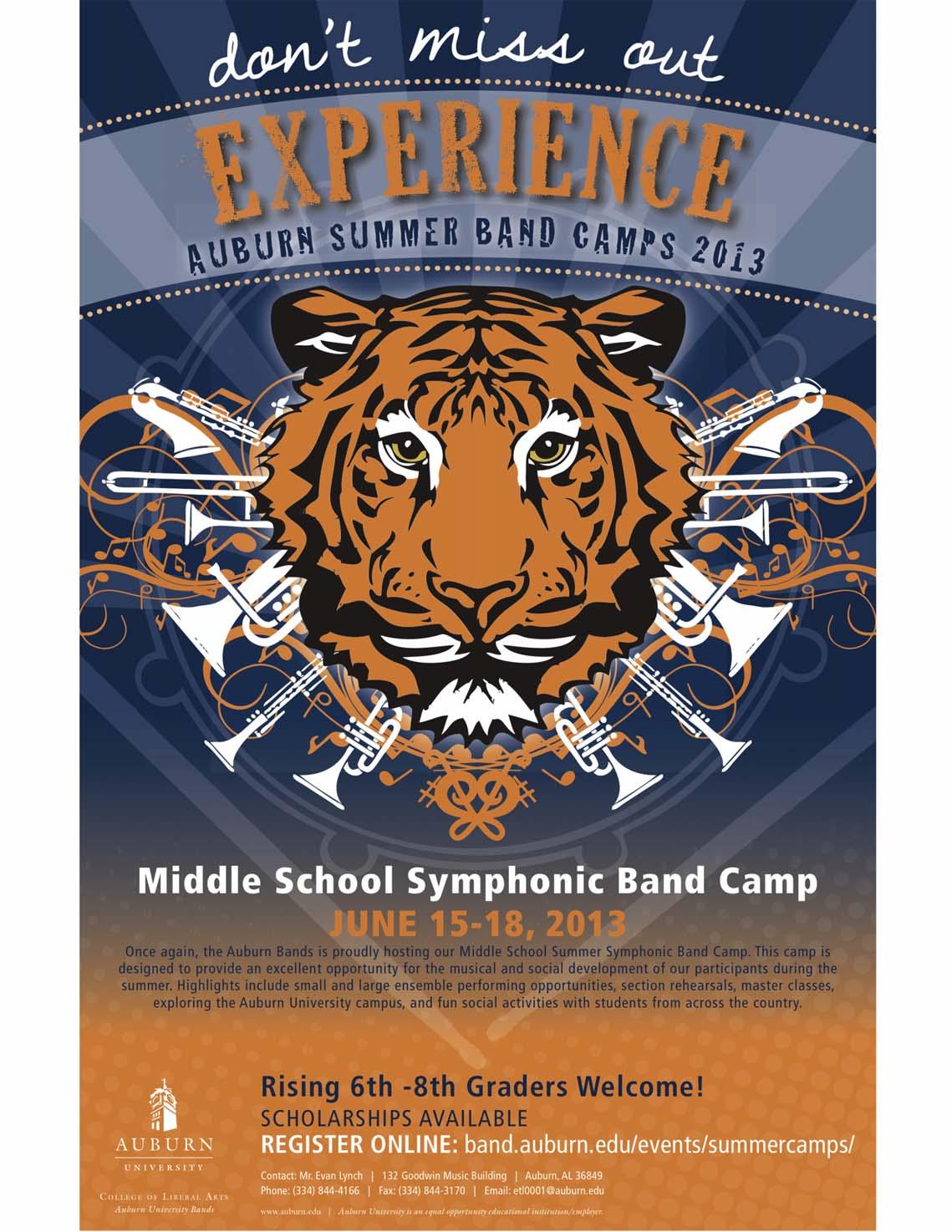
Saturday, February 9 | Saturday, February 23
INSTRUMENTAL ENSEMBLES
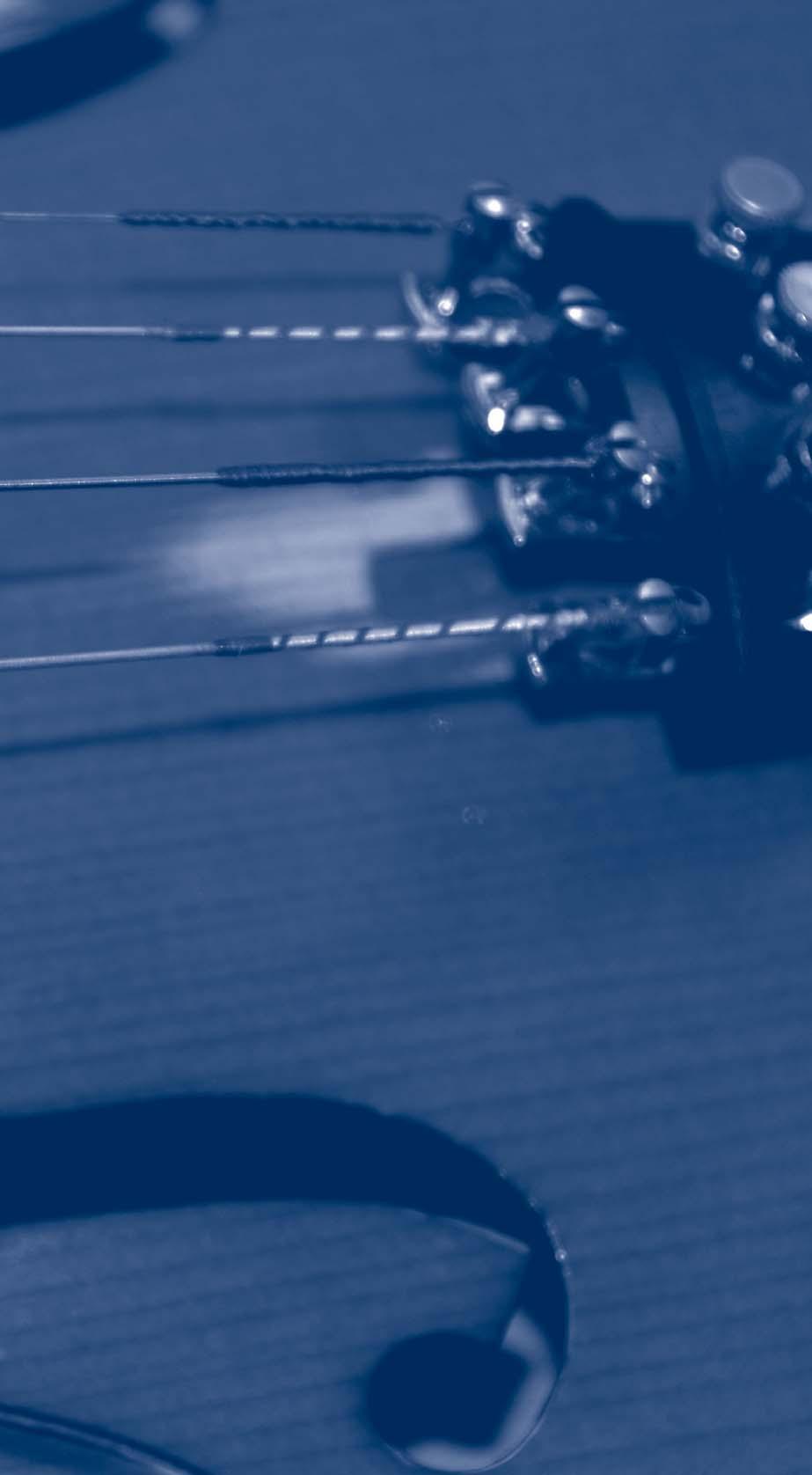
• Symphonic Band
• Orchestra
• Concert Band
• Campus Band
• Marching Band
• Percussion Ensemble
• Jazz Band
• Trumpet Ensemble
• Low Brass Ensemble
• Wind Quintets
CHORAL / VOCAL ENSEMBLES
• Chamber Choir
• Concert Choir
• Gospel Choir
• Men’s Chorus
• Conductor’s Chorus
• Women’s Chorus
• Opera Workshop
• AU Singers
DEGREES
• Bachelor of Arts in Music
at AUBURN UNIVERSITY
www.auburn.edu/music
• Bachelor of Music
• Bachelor of Music Education
• Master of Education in Music Education
• Education Specialist in Music Education
• Doctor of Philosophy in Music Education
FOR MORE INFORMATION
Auburn University
Department of Music 101 Goodwin Music Building Auburn, AL 36849-5420
Phone: 334.844.4165
Fax: 334.844.3168
Email: music@auburn.edu www.auburn.edu/music

